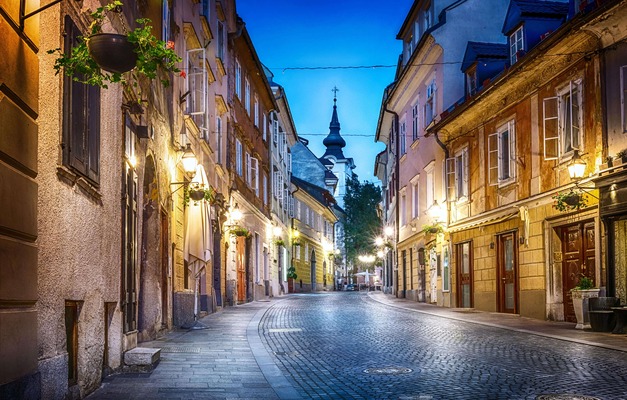
Dreaming the Italian Classics: A 10-day voyage through Rome, Florence & Venice
 10 Day Tour of Rome, Florence and Venice
10 Day Tour of Rome, Florence and Venice
Overview
Trip Map
Itinerary
Inclusions
Reviews







10 Days 9 Nights
Best Time: Jan-Dec
Visiting Museums & Art Galleries
History Buffs
On this 10-day trip, you'll roam Rome from the Vatican City to the Colosseum to the Trevi fountain. Leave the imperial city by train past incredible views of olive groves and hillside vineyards to see Michelangelo's "David" and the Duomo of Santa Maria in Florence. After a cooking class with a good glass of Chianti Classico, ride on to Venice to wander amidst its iconic canals to the sublime Piazza San Marco. With our detailed itinerary directions and guided tours in each city, this tour delivers an iconic Italy, whether you are a single traveler, on a family trip, or with a special someone.
- Discover the Classical Roman World at the Roman Forum, Palantine Hill, and Piazza Navona
- Become a foodie cognoscenti in Rome's Trastevere neighborhood.
- Understand the heart of Renaissance art in Florence, and admire some of the world's greatest art
- Stroll the ornate Rialto Bridge over the canals of Venice, and find the best local cappuccino.
On this 10-day trip, you'll roam Rome from the Vatican City to the Colosseum to the Trevi fountain. Leave the imperial city by train past incredible views of olive groves and hillside vineyards to see Michelangelo's "David" and the Duomo of Santa Maria in Florence. After a cooking class with a good glass of Chianti Classico, ride on to Venice to wander amidst its iconic canals to the sublime Piazza San Marco. With our detailed itinerary directions and guided tours in each city, this tour delivers an iconic Italy, whether you are a single traveler, on a family trip, or with a special someone.
- Discover the Classical Roman World at the Roman Forum, Palantine Hill, and Piazza Navona
- Become a foodie cognoscenti in Rome's Trastevere neighborhood.
- Understand the heart of Renaissance art in Florence, and admire some of the world's greatest art
- Stroll the ornate Rialto Bridge over the canals of Venice, and find the best local cappuccino.

Colosseum
Historic Landmarks

Vatican City
Churches & Monasteries

Trevi Fountain
Historic Landmarks

Piazza del Duomo
Churches & Monasteries

Uffizi Gallery
Museums & Galleries

Galleria dell'Accademia
Museums & Galleries

Oltrarno & Piazzale Michelangelo
Cultural

Grand Canal
European History

Saint Mark's Basilica
Architecture
Must see sights

Colosseum
Historic Landmarks

Vatican City
Churches & Monasteries

Trevi Fountain
Historic Landmarks

Piazza del Duomo
Churches & Monasteries

Uffizi Gallery
Museums & Galleries

Galleria dell'Accademia
Museums & Galleries

Oltrarno & Piazzale Michelangelo
Cultural

Grand Canal
European History

Saint Mark's Basilica
Architecture
Starting from
$4033
per person
 Not included
Not included Secure Your Customizable Trip
Enter your details to embark on a journey that can be tailored just for you.
Start
Travelers
0 travelers
Add Room
Remove Room
Preferred Hotel Stars
Select Hotel Stars
Craft Your Own Itinerary
Select your interests and destinations for a trip plan inspired by you.
Trip Map & Itinerary
Enable/Disable Map Scrolling
Click To Make Map Interactive

Trip Timeline
 Edit Details
Edit DetailsArrival
3 nights
Rome
Italy
Train: 2h
3 nights
Florence
Italy
Train: 2.5h
3 nights
Venice
Italy
Departure
Day-By-Day Itinerary
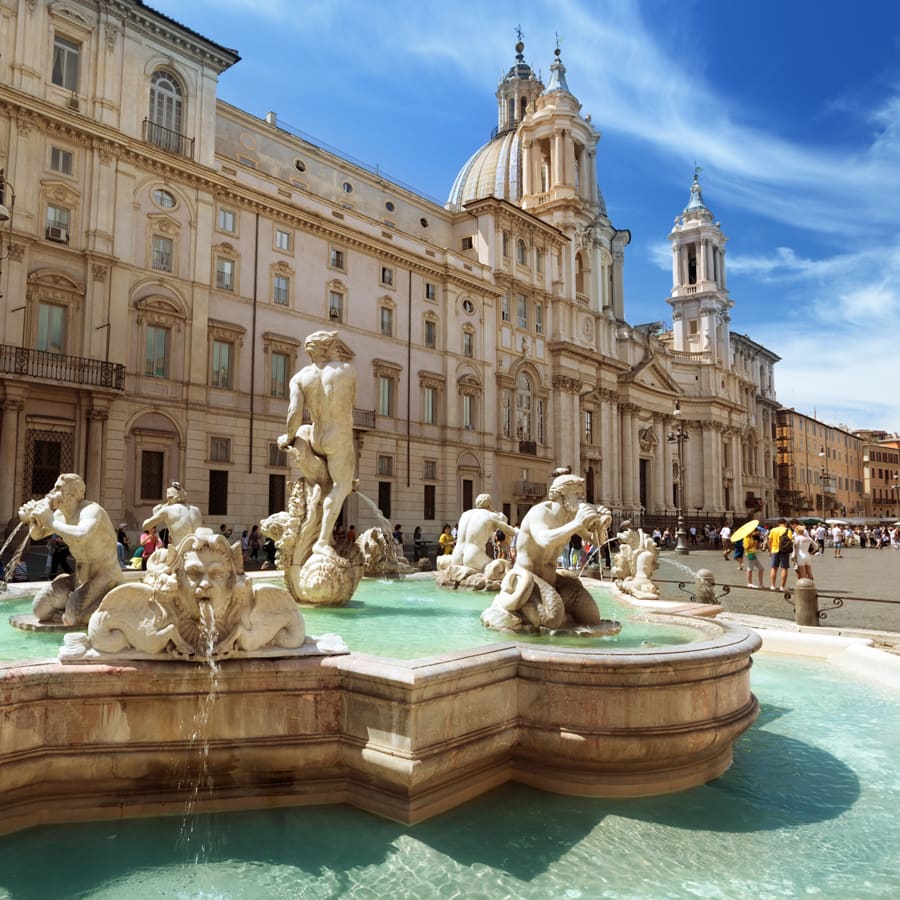
Day 1
Arrive Rome
Day 1
Arrive Rome



11:30 AM
Private Transfer from Rome Fiumicino to Hotel
For your arrival in Rome, we will provide information on the customs and passport procedures. We will schedule a pick up for your flight's arrival time. You will be met at arrivals inside the terminal by a driver holding a sign with your name on it. The transfer is for your party only - you will not be sharing a vehicle. The cost of the ride will be included in your itinerary package and you will be taken directly to your hotel. IMPORTANT NOTE: Please be aware the car service can fit up to 1 checked item of luggage and 1 personal item per person, such as a purse or small backpack. If you think you will have more baggage, please inform your travel consultant as this may result in an additional fee.

Day 1
Arrive Rome


Day 1
Arrive Rome




11:30 AM:
Private Transfer to your Hotel
Mid-Day:
Rome's Historic Center
Afternoon:
Dining in Piazza Navona


Day 2
Rome
Day 2
Rome



9:30 AM - 12:30 PM
Heart of the Empire - Private Tour of Ancient Rome & the Colosseum
On this 3-hour private guided tour, you will explore the imposing remains of ancient Rome. Your guide will explain the extraordinary history of the birth of Rome, life in the city and everything about the fall of the Empire. Visit the Colosseum, the monumental ruins of the Roman Forum, and end the tour on the Capitoline Hill, the smallest and most important of the seven hills of Ancient Rome.

Colosseum
Ancient Roman Ampitheater
Show More

Colosseum
Ancient Roman Ampitheater
Show More

Colosseum
Ancient Roman Ampitheater
Show More

Colosseum
Ancient Roman Ampitheater
Show More

Colosseum
Ancient Roman Ampitheater
Show More
prev
next

Day 2
Rome

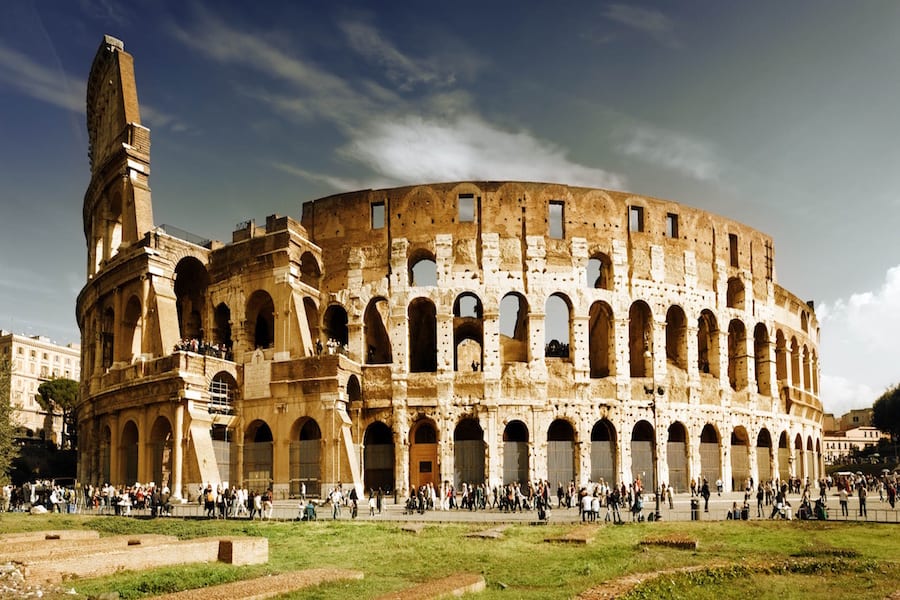
Colosseum
 Highlight of Ancient Rome Guided Walk
Highlight of Ancient Rome Guided WalkAncient Roman Ampitheater
Monumental Roman amphitheater once used for gladiatorial games

Colosseum
 Highlight of Ancient Rome Guided Walk
Highlight of Ancient Rome Guided WalkAncient Roman Ampitheater
Monumental Roman amphitheater once used for gladiatorial games

Colosseum
 Highlight of Ancient Rome Guided Walk
Highlight of Ancient Rome Guided WalkAncient Roman Ampitheater
Monumental Roman amphitheater once used for gladiatorial games

Colosseum
 Highlight of Ancient Rome Guided Walk
Highlight of Ancient Rome Guided WalkAncient Roman Ampitheater
Monumental Roman amphitheater once used for gladiatorial games

Colosseum
 Highlight of Ancient Rome Guided Walk
Highlight of Ancient Rome Guided WalkAncient Roman Ampitheater
Monumental Roman amphitheater once used for gladiatorial games
prev
next

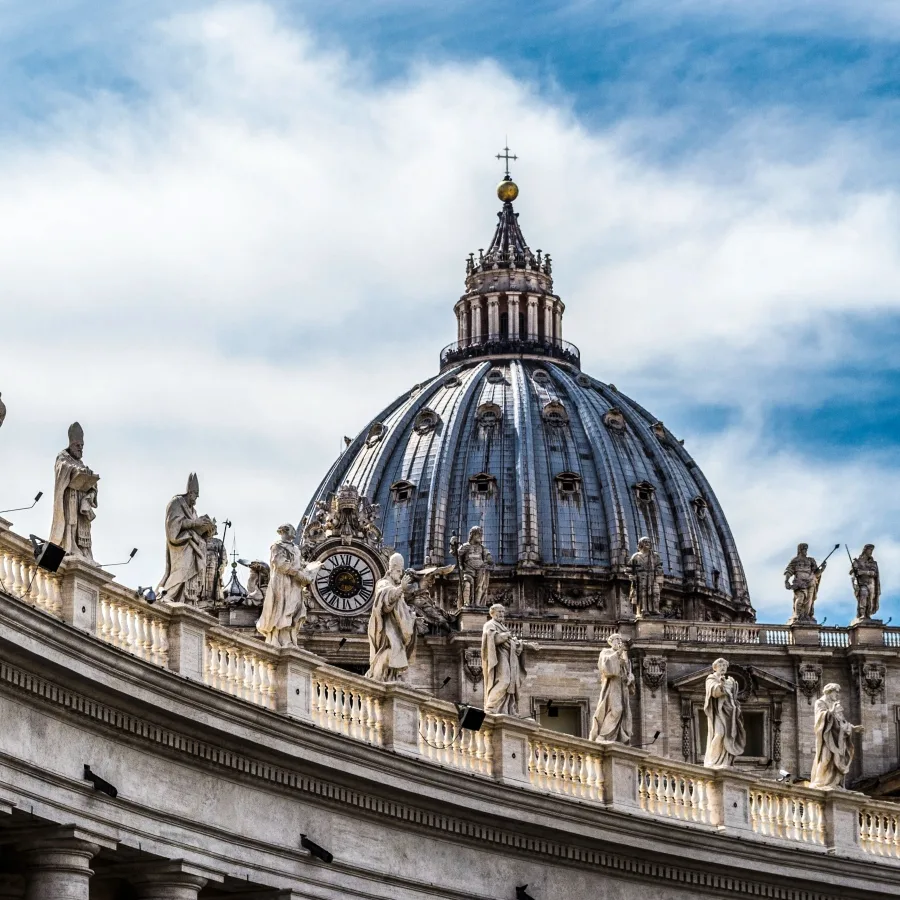
Day 3
Rome
Day 3
Rome



Early Morning to Mid-Day
Explore the Vatican City's Many Wonders
Rome is unique in the world in that it contains an independent country within its city limits - the Vatican City, from where the Pope administers the Catholic Church. The symbolic center of Catholicism is St Peter's Basilica, the second-largest Catholic church in the world and among the most beautiful. The Vatican Museum contains one of the greatest collections of art in existence, including Michelangelo's jaw-dropping Sistine Chapel. The popes had a bigger influence on Rome than just the collection of art. The Pope's title is actually Bishop of Rome, and popes administed the city for centuries, shaping its architecture & public spaces. Rome was re-built to be an example of urban beauty, and the Vatican was meant to be the showcase within the showcase. Their success is evident from the throngs of visitors who flock here even today.

Vatican Museums
Book early if you want to see the Vatican Museum's monumental works of art from the greatest Italian artists of the Renaissance.
Show More

St Peter’s Basilica
Explore the gigantic and incredibly beautiful church known as "the greatest of all churches of Christendom".
Show More

Vatican Gardens
Escape the crowds in this oasis of green hidden behind the walls of the Vatican.
Show More

St Peter's Square
Stand in the middle of this famous square in which the faithful gather to hear the Pope give audiences and celebrate mass.
Show More

Sistine Chapel
Gaze up at the world's most famous ceiling, the masterpiece of Michelangelo.
Show More

Vatican Museums
Book early if you want to see the Vatican Museum's monumental works of art from the greatest Italian artists of the Renaissance.
Show More

St Peter’s Basilica
Explore the gigantic and incredibly beautiful church known as "the greatest of all churches of Christendom".
Show More

Vatican Gardens
Escape the crowds in this oasis of green hidden behind the walls of the Vatican.
Show More

St Peter's Square
Stand in the middle of this famous square in which the faithful gather to hear the Pope give audiences and celebrate mass.
Show More

Sistine Chapel
Gaze up at the world's most famous ceiling, the masterpiece of Michelangelo.
Show More

Vatican Museums
Book early if you want to see the Vatican Museum's monumental works of art from the greatest Italian artists of the Renaissance.
Show More
prev
next

Day 3
Rome

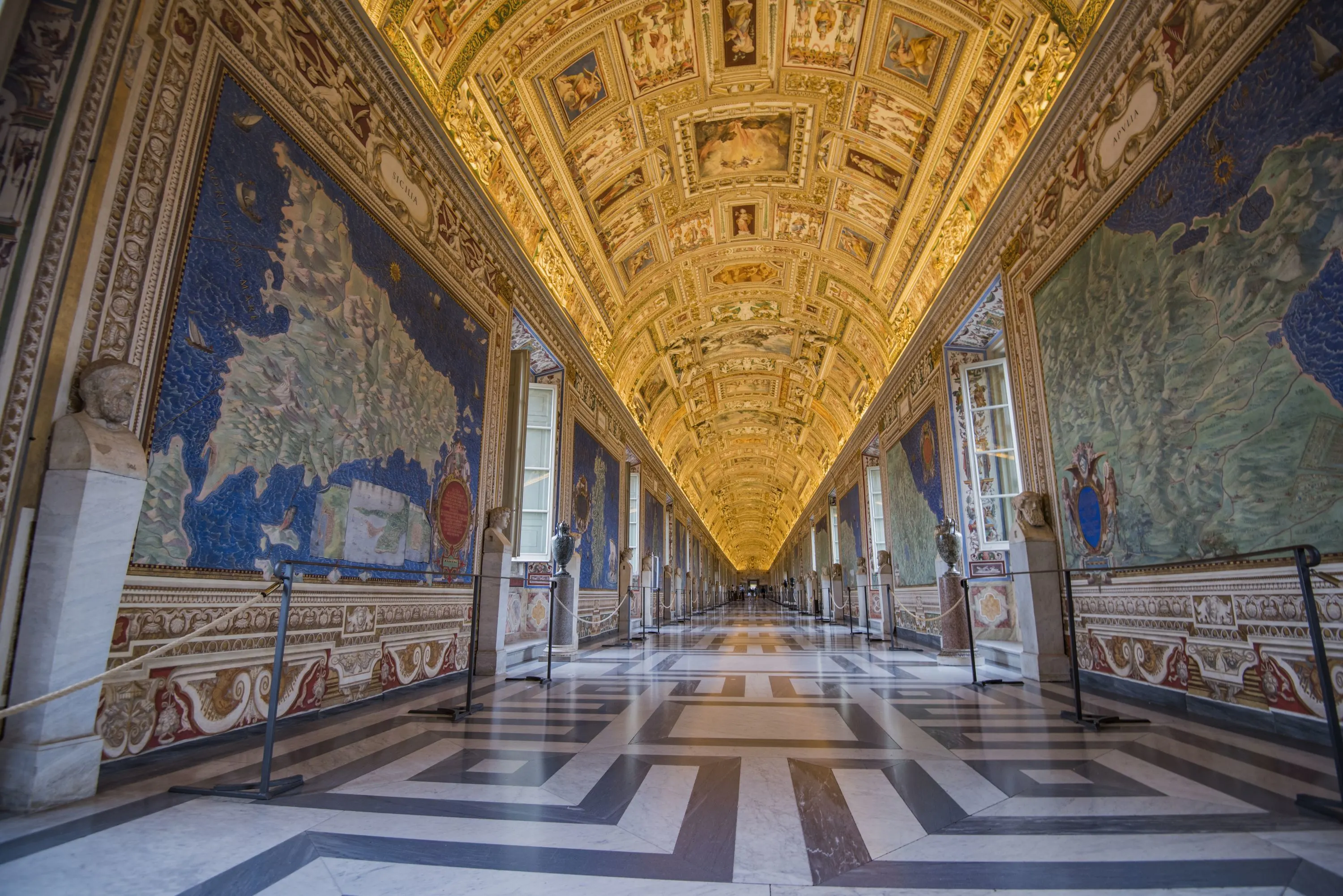
Vatican Museums
 Highlight of Vatican City
Highlight of Vatican CityBook early if you want to see the Vatican Museum's monumental works of art from the greatest Italian artists of the Renaissance.
The Vatican Museum is actually 26 different museums, which include not only exhibitions but chapels, apartments, and other rooms of the Vatican palace, covering a huge range of fine and applied arts patronized by the popes. There's also an outstanding collection of ancient antiquities (including even the Emperor Nero's red stone bathtub), a gallery of hand-painted maps, and whole rooms turned into works of art. In addition to ancient and medieval works of art, you'll see masterpieces by the "who's who" of the Italian Renaissance, including Raphael, Leonardo da Vinci, Titian, and Caravaggio. Other highlights include panels by the brilliant monk-artist Fra Angelico, works from the Venetian school, including Vavarini, and much, much more. Booking in advance is highly recommended as otherwise you can wait for hours or not even be able to get in at all.
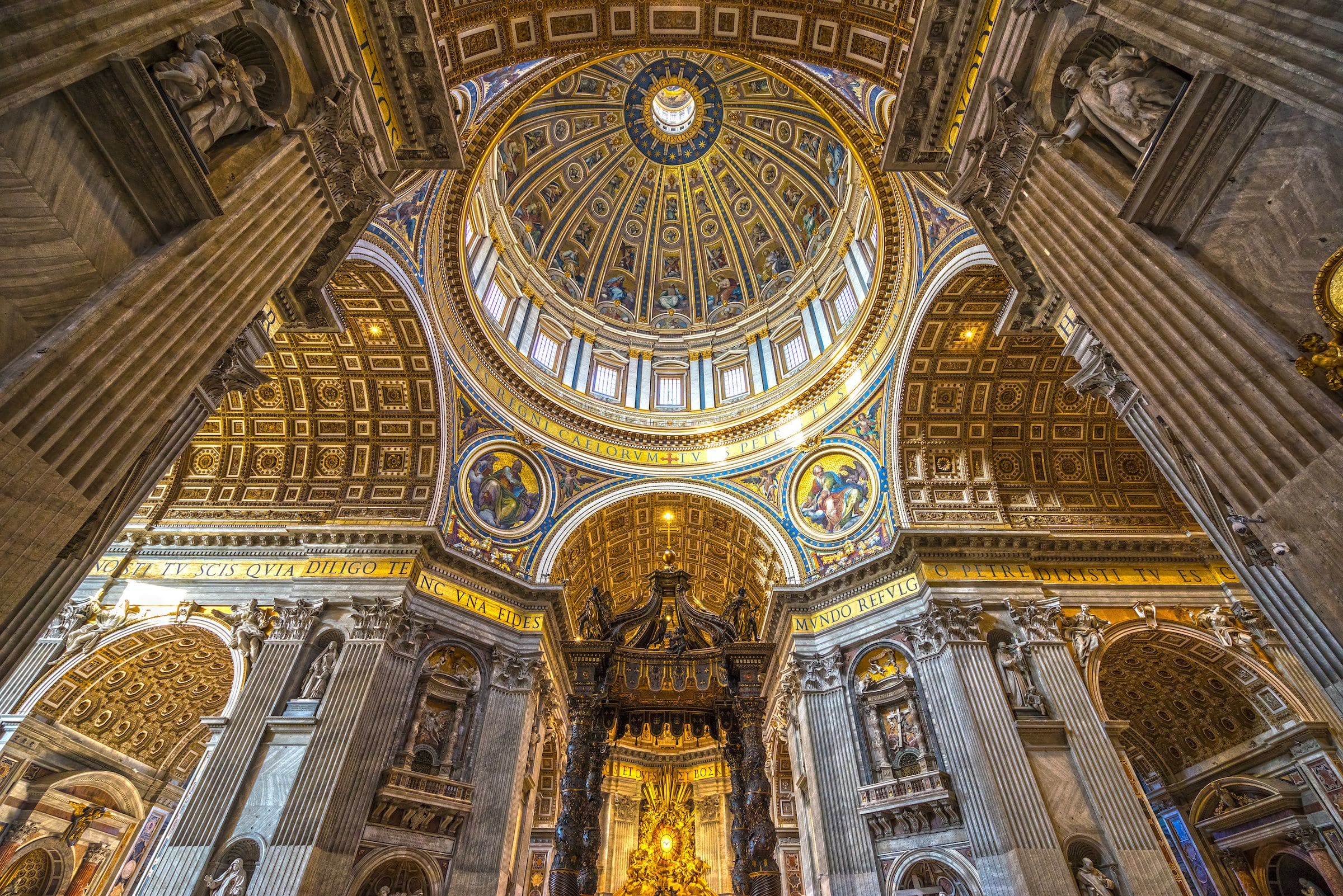
St Peter’s Basilica
 Highlight of Vatican City
Highlight of Vatican CityExplore the gigantic and incredibly beautiful church known as "the greatest of all churches of Christendom".
The basilica is one of the chief pilgrimage sites in the Christian world, and one of the most popular tourist destinations in Rome. The basilica is the symbolic center of the church not only because the Pope frequently celebrates Mass there, but because it is believed that the apostle St. Peter is buried beneath it. Catholics consider Peter as the first Bishop of Rome and "the rock" upon which the Catholic Church was built, in accordance with Christ's instructions. Inside you can admire sculptures by Bernini as well as Michelangelo's famous sculpture of the Virgin Mary holding the crucified Jesus, known as The Pietà. The church's elaborate and impressive golden interior is a sight to behold. Other sights include St Peter's tomb, the Papal crypts in the necropolis under the basilica, as well as the dome, which rewards visitors with views over Rome. Entry is free, but queues to visit the Basilica can be lengthy, so it is highly advised to either get there early or to purchase a skip the line entrance. The dome is also paid entry.
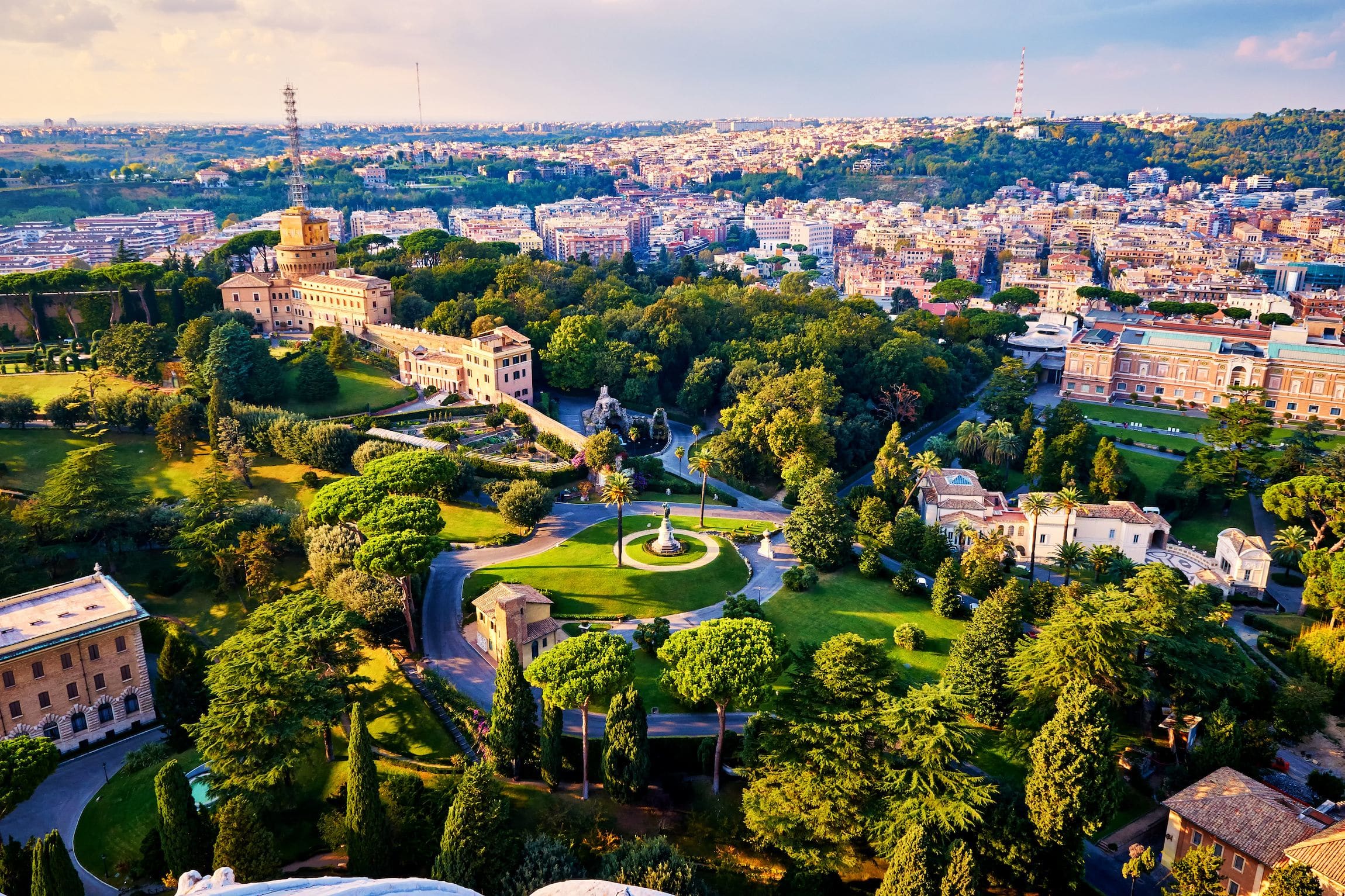
Vatican Gardens
 Highlight of Vatican City
Highlight of Vatican CityEscape the crowds in this oasis of green hidden behind the walls of the Vatican.
Accessible only via a guided tour, the gardens are definitely worth a visit. Just as the Popes have for hundreds of years, you can stroll the gardens and relax amidst the greenery, while taking in the perfect view of St. Peter's.
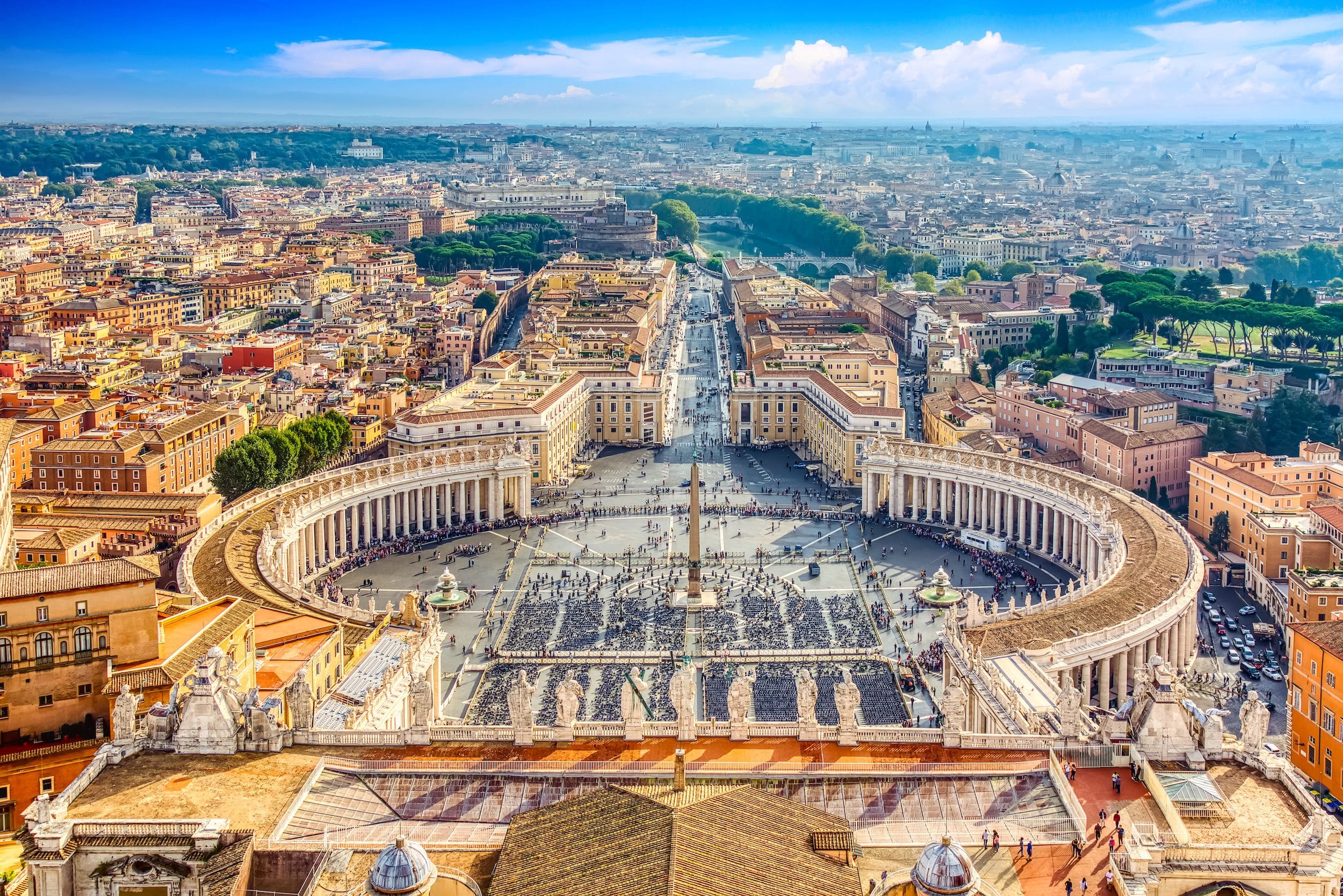
St Peter's Square
 Highlight of Vatican City
Highlight of Vatican CityStand in the middle of this famous square in which the faithful gather to hear the Pope give audiences and celebrate mass.
As one of the most superb conceptions of its kind in civic architecture, St Peter’s Square is the masterpiece of Gian Lorenzo Bernini and makes a wonderful approach to one of the world’s most magnificent churches, St Peter's Basilica. An oval rather than an actual square, the piazza, laid out in 1656-67, is partially enclosed by two semi-circular colonnades on which stand 96 statues of saints and martyrs. At the center of the oval stands an 84-foot (26m) tall Egyptian obelisk of red granite.
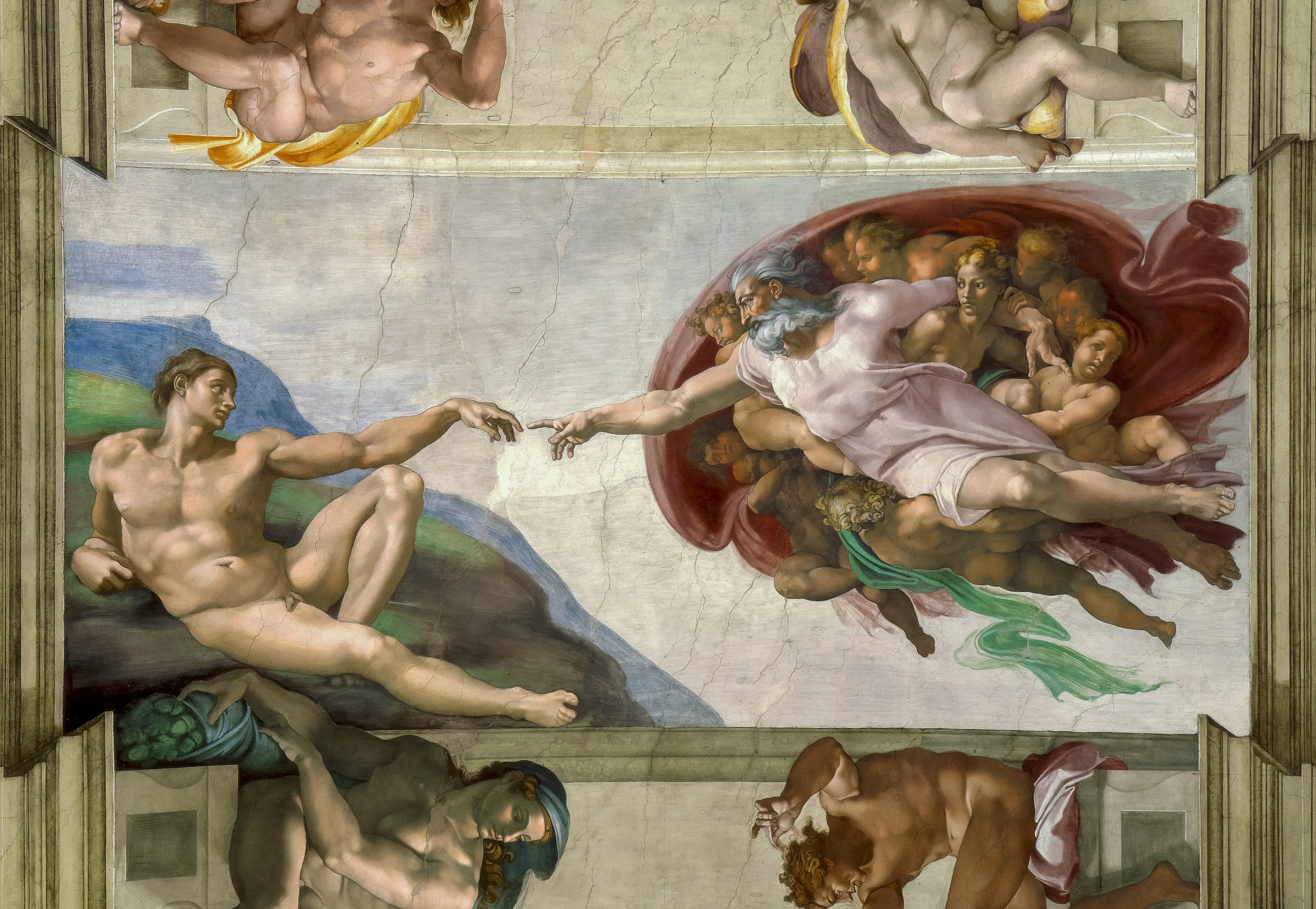
Sistine Chapel
 Highlight of Vatican City
Highlight of Vatican CityGaze up at the world's most famous ceiling, the masterpiece of Michelangelo.
This famous chapel inside the Vatican Museums is best known for Michelangelo's 16th-century painted ceiling of "The Creation of Adam" and "The Last Judgement" fresco that covers the whole altar wall of the chapel. The jaw-dropping sight is not to be missed, considered one of the top highlights of visiting the Vatican Museums and one of the top artistic wonders of the world.

Vatican Museums
 Highlight of Vatican City
Highlight of Vatican CityBook early if you want to see the Vatican Museum's monumental works of art from the greatest Italian artists of the Renaissance.
The Vatican Museum is actually 26 different museums, which include not only exhibitions but chapels, apartments, and other rooms of the Vatican palace, covering a huge range of fine and applied arts patronized by the popes. There's also an outstanding collection of ancient antiquities (including even the Emperor Nero's red stone bathtub), a gallery of hand-painted maps, and whole rooms turned into works of art. In addition to ancient and medieval works of art, you'll see masterpieces by the "who's who" of the Italian Renaissance, including Raphael, Leonardo da Vinci, Titian, and Caravaggio. Other highlights include panels by the brilliant monk-artist Fra Angelico, works from the Venetian school, including Vavarini, and much, much more. Booking in advance is highly recommended as otherwise you can wait for hours or not even be able to get in at all.

St Peter’s Basilica
 Highlight of Vatican City
Highlight of Vatican CityExplore the gigantic and incredibly beautiful church known as "the greatest of all churches of Christendom".
The basilica is one of the chief pilgrimage sites in the Christian world, and one of the most popular tourist destinations in Rome. The basilica is the symbolic center of the church not only because the Pope frequently celebrates Mass there, but because it is believed that the apostle St. Peter is buried beneath it. Catholics consider Peter as the first Bishop of Rome and "the rock" upon which the Catholic Church was built, in accordance with Christ's instructions. Inside you can admire sculptures by Bernini as well as Michelangelo's famous sculpture of the Virgin Mary holding the crucified Jesus, known as The Pietà. The church's elaborate and impressive golden interior is a sight to behold. Other sights include St Peter's tomb, the Papal crypts in the necropolis under the basilica, as well as the dome, which rewards visitors with views over Rome. Entry is free, but queues to visit the Basilica can be lengthy, so it is highly advised to either get there early or to purchase a skip the line entrance. The dome is also paid entry.

Vatican Gardens
 Highlight of Vatican City
Highlight of Vatican CityEscape the crowds in this oasis of green hidden behind the walls of the Vatican.
Accessible only via a guided tour, the gardens are definitely worth a visit. Just as the Popes have for hundreds of years, you can stroll the gardens and relax amidst the greenery, while taking in the perfect view of St. Peter's.

St Peter's Square
 Highlight of Vatican City
Highlight of Vatican CityStand in the middle of this famous square in which the faithful gather to hear the Pope give audiences and celebrate mass.
As one of the most superb conceptions of its kind in civic architecture, St Peter’s Square is the masterpiece of Gian Lorenzo Bernini and makes a wonderful approach to one of the world’s most magnificent churches, St Peter's Basilica. An oval rather than an actual square, the piazza, laid out in 1656-67, is partially enclosed by two semi-circular colonnades on which stand 96 statues of saints and martyrs. At the center of the oval stands an 84-foot (26m) tall Egyptian obelisk of red granite.

Sistine Chapel
 Highlight of Vatican City
Highlight of Vatican CityGaze up at the world's most famous ceiling, the masterpiece of Michelangelo.
This famous chapel inside the Vatican Museums is best known for Michelangelo's 16th-century painted ceiling of "The Creation of Adam" and "The Last Judgement" fresco that covers the whole altar wall of the chapel. The jaw-dropping sight is not to be missed, considered one of the top highlights of visiting the Vatican Museums and one of the top artistic wonders of the world.

Vatican Museums
 Highlight of Vatican City
Highlight of Vatican CityBook early if you want to see the Vatican Museum's monumental works of art from the greatest Italian artists of the Renaissance.
The Vatican Museum is actually 26 different museums, which include not only exhibitions but chapels, apartments, and other rooms of the Vatican palace, covering a huge range of fine and applied arts patronized by the popes. There's also an outstanding collection of ancient antiquities (including even the Emperor Nero's red stone bathtub), a gallery of hand-painted maps, and whole rooms turned into works of art. In addition to ancient and medieval works of art, you'll see masterpieces by the "who's who" of the Italian Renaissance, including Raphael, Leonardo da Vinci, Titian, and Caravaggio. Other highlights include panels by the brilliant monk-artist Fra Angelico, works from the Venetian school, including Vavarini, and much, much more. Booking in advance is highly recommended as otherwise you can wait for hours or not even be able to get in at all.
prev
next

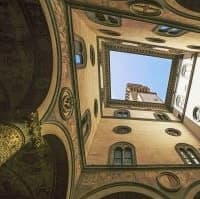
Day 4
Rome to Florence
Day 4
Rome to Florence





9:25 AM
Private Transfer to Rome Termini Train Station
A private transfer service will pick you up from the N/A and deliver you to Rome Termini Train Station. Your itinerary will provide detailed information on navigating the train station and finding your train, making the whole process simple and stress-free.

Day 4
Rome to Florence


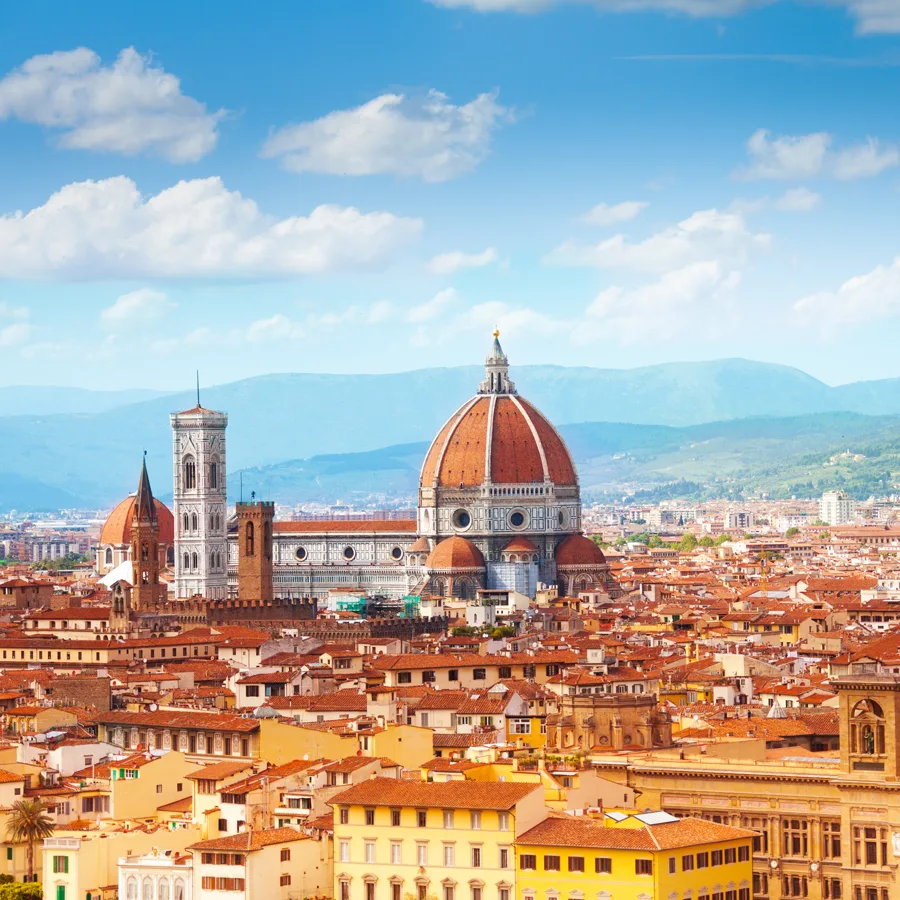
Day 5
Florence
Day 5
Florence




9:30 AM - 12:30 PM
Best of Florence: Half-Day Walking Tour
Enjoy a 3-hour private walking tour of Florence, the perfect introduction to the masterpieces of this city. Stroll around the historic center and take in sights such as the Palazzo Vecchio, Ponte Vecchio, Piazza Della Signora and end your tour at the famous Galleria dell'Accademia where you can enter to see Michelangelo's marble masterpiece, the statue of David.

Galleria dell'Accademia
Art museum and home to Michelangelo's famous David
Show More

Galleria dell'Accademia
Art museum and home to Michelangelo's famous David
Show More

Galleria dell'Accademia
Art museum and home to Michelangelo's famous David
Show More

Galleria dell'Accademia
Art museum and home to Michelangelo's famous David
Show More

Galleria dell'Accademia
Art museum and home to Michelangelo's famous David
Show More
prev
next

Day 5
Florence

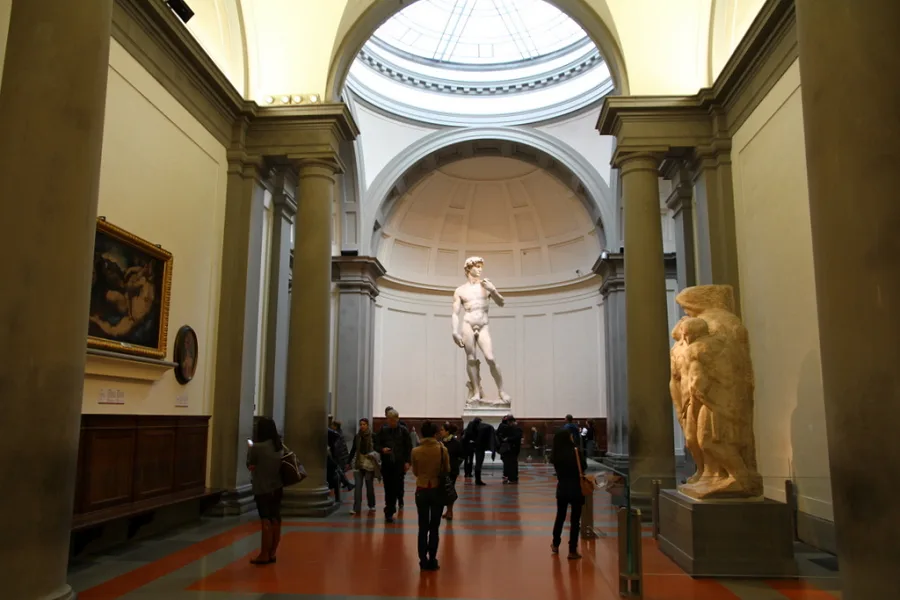
Galleria dell'Accademia
 Highlight of Private Guided Walk in Florence
Highlight of Private Guided Walk in FlorenceArt museum and home to Michelangelo's famous David
The Gallery's prized exhibits are naturally its works by Michelangelo, including in addition to David his unfinished Slaves (or Prisoners).

Galleria dell'Accademia
 Highlight of Private Guided Walk in Florence
Highlight of Private Guided Walk in FlorenceArt museum and home to Michelangelo's famous David
The Gallery's prized exhibits are naturally its works by Michelangelo, including in addition to David his unfinished Slaves (or Prisoners).

Galleria dell'Accademia
 Highlight of Private Guided Walk in Florence
Highlight of Private Guided Walk in FlorenceArt museum and home to Michelangelo's famous David
The Gallery's prized exhibits are naturally its works by Michelangelo, including in addition to David his unfinished Slaves (or Prisoners).

Galleria dell'Accademia
 Highlight of Private Guided Walk in Florence
Highlight of Private Guided Walk in FlorenceArt museum and home to Michelangelo's famous David
The Gallery's prized exhibits are naturally its works by Michelangelo, including in addition to David his unfinished Slaves (or Prisoners).

Galleria dell'Accademia
 Highlight of Private Guided Walk in Florence
Highlight of Private Guided Walk in FlorenceArt museum and home to Michelangelo's famous David
The Gallery's prized exhibits are naturally its works by Michelangelo, including in addition to David his unfinished Slaves (or Prisoners).
prev
next

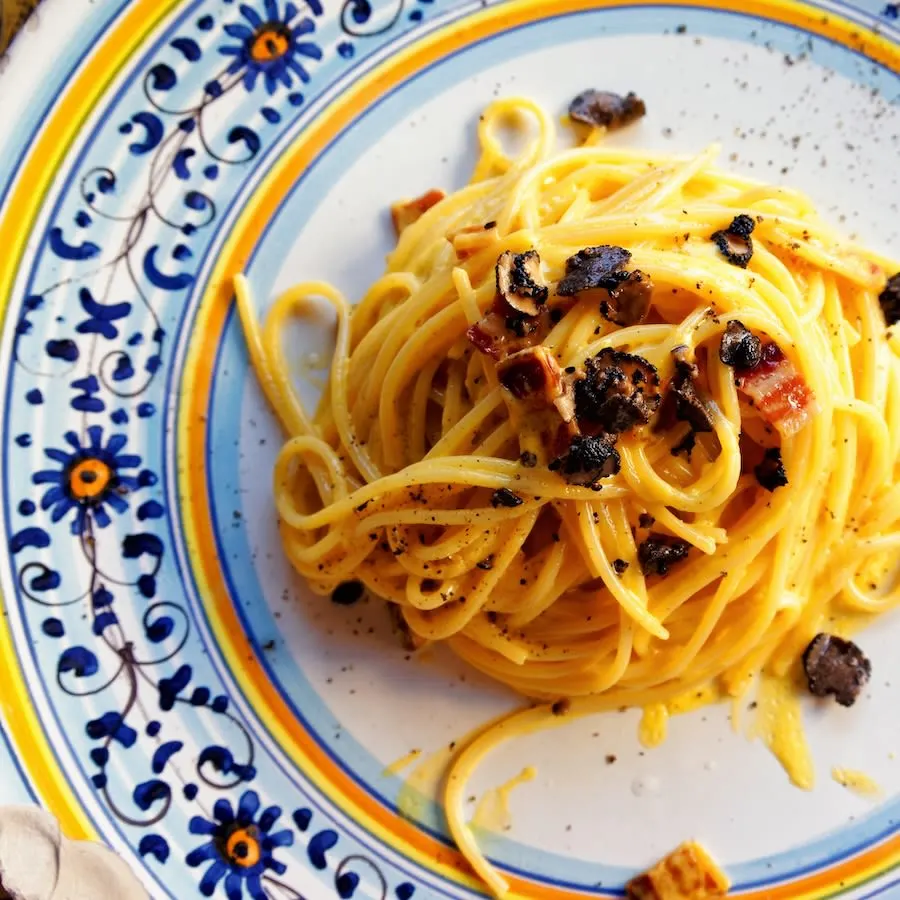
Day 6
Florence
Day 6
Florence



10:00 AM - 2:00 PM
Tuscan Cuisine Cooking Class
Tuscany is blessed with the perfect climate and location for food, producing a diverse bounty of fresh fruits and vegetables, wild game, beef & pork, and seafood. In fact, when you consider the quality of ingredients produced here, you understand why Tuscan cooking is not just about recipes, but about bringing out the best of the ingredients. Even within Italy, Tuscany is renowned for its cuisine. Taking a cooking class can introduce you to the magic, teaching you how to make traditional Tuscan starters, pastas, main courses, and deserts.

Day 6
Florence


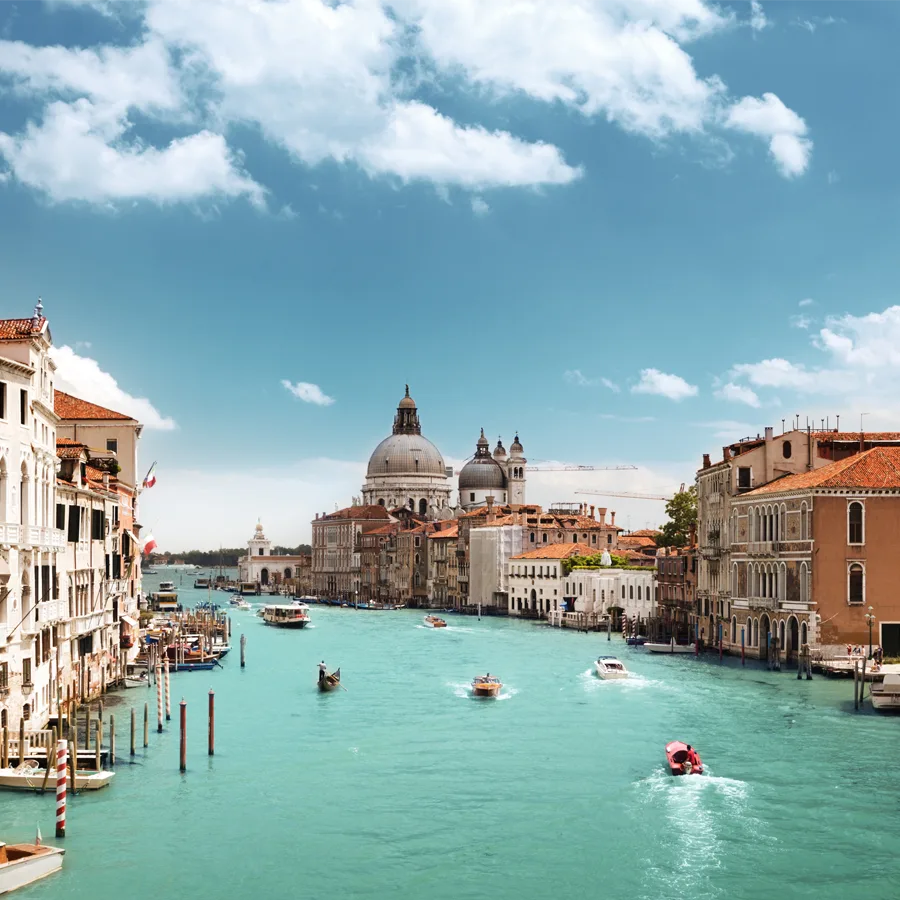
Day 7
Florence to Venice
Day 7
Florence to Venice





8:20 AM
Transfer to Station by Taxi or Public Transport
Most trains depart from Firenza S.M.N. (i.e. Florence Santa Maria Novella Station) station, the largest station in the city. Before spending money on a transfer, be sure to check whether your hotel is within easy walking distance. Also consider that public transport is the cheapest and sometimes fastest option; trams and buses drop off next to the station. Uber is available in Florence, and if staying at a hotel, they can order a reliable taxi. Some private transfers will even help with your bags.

Day 7
Florence to Venice


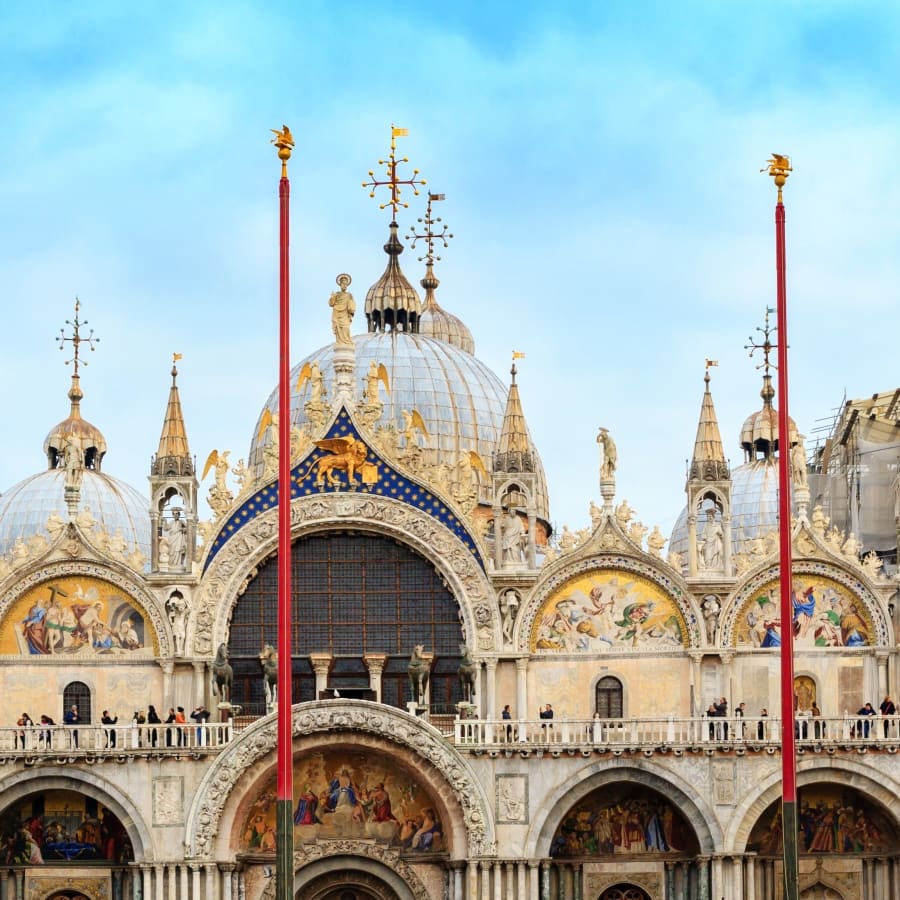
Day 8
Venice
Day 8
Venice



9:30 AM - 12:30 PM
'First Walk' Guided Tour in Venice
If you are a first-time visitor to Venice, the best approach is an introductory tour. This 3-hour private guided walking excursion begins with a selection of the “must sees,” including St. Mark's Square, the former political center of the Venetian Republic, with its many famous buildings: the Doges' Palace, the Bridge of Sighs, the Marciana Library, the Bell Tower, and the Clock Tower. You'll end your tour in the Rialto neighborhood next to the famous Rialto Bridge.

Doges' Palace
Explore the staterooms and masterpieces inside this famous Gothic-style Palace.
Show More

Doges' Palace
Explore the staterooms and masterpieces inside this famous Gothic-style Palace.
Show More

Doges' Palace
Explore the staterooms and masterpieces inside this famous Gothic-style Palace.
Show More

Doges' Palace
Explore the staterooms and masterpieces inside this famous Gothic-style Palace.
Show More

Doges' Palace
Explore the staterooms and masterpieces inside this famous Gothic-style Palace.
Show More
prev
next

Day 8
Venice

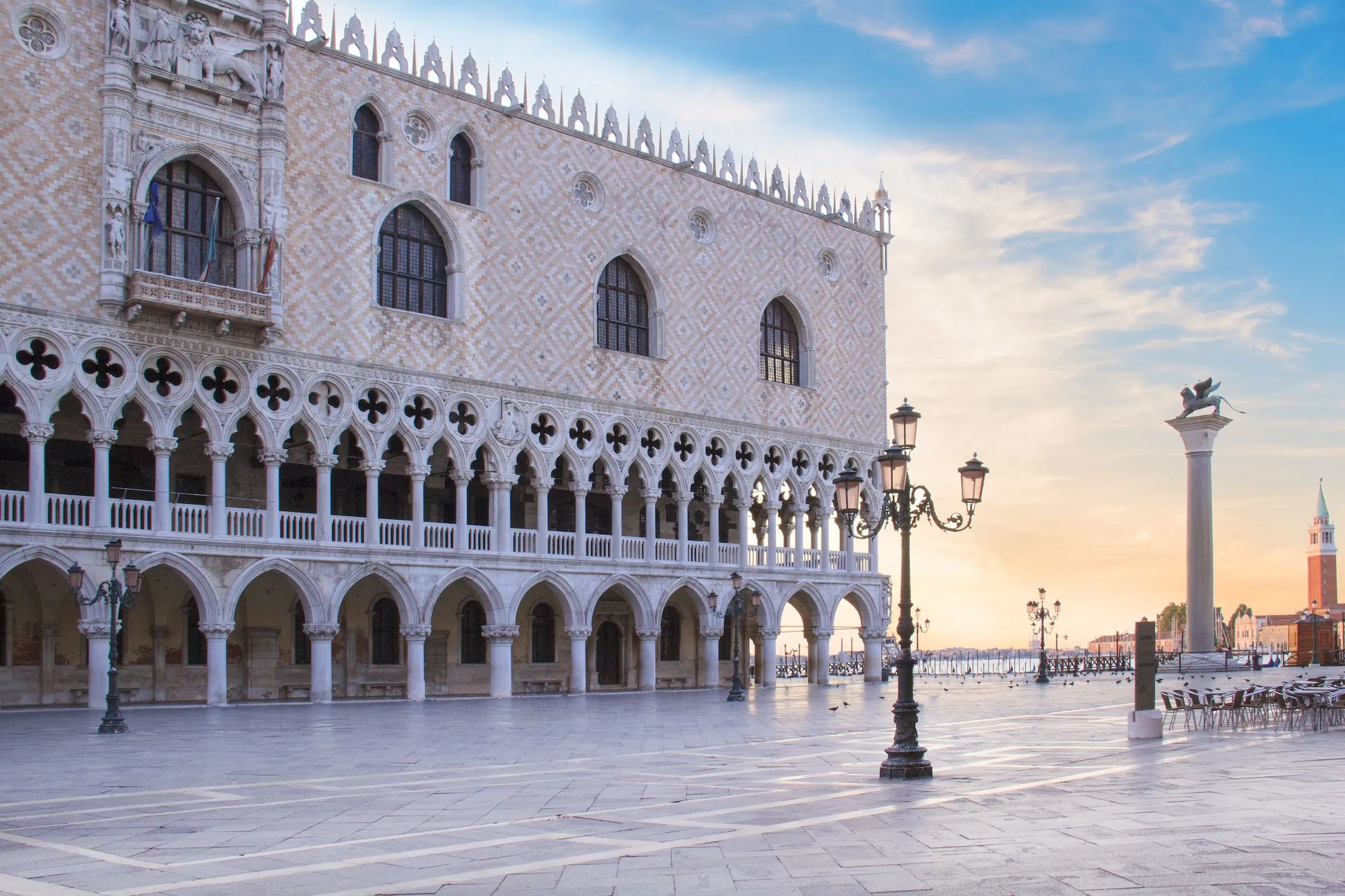
Doges' Palace
 Highlight of 'First Walk', Guided Tour in Venice
Highlight of 'First Walk', Guided Tour in VeniceExplore the staterooms and masterpieces inside this famous Gothic-style Palace.
Important Note: Entry lines can be very long. We suggest taking advantage of skip the line entry. As the name suggests, the Palace was the official residence of the Venetian rulers, the Doges, and the chief magistrates. The building was founded in the 9th century, but the present one dates from the 14th century. Tour its elaborate staterooms, grand halls and the 24-carat golden staircase before seeking out its collection of priceless masterpieces by Venetian artists including Titan, Veronese and Tintoretto. Be sure to spend some time in the most incredible room of all, the Chamber of the Great Council, the assembly hall where all Venetian patricians gathered to participate in the running of the city - up to 2,500 at any one time. There you will find the Doge's throne and the world's longest canvas painting in the world, Tintoretto's Il Paradiso.

Doges' Palace
 Highlight of 'First Walk', Guided Tour in Venice
Highlight of 'First Walk', Guided Tour in VeniceExplore the staterooms and masterpieces inside this famous Gothic-style Palace.
Important Note: Entry lines can be very long. We suggest taking advantage of skip the line entry. As the name suggests, the Palace was the official residence of the Venetian rulers, the Doges, and the chief magistrates. The building was founded in the 9th century, but the present one dates from the 14th century. Tour its elaborate staterooms, grand halls and the 24-carat golden staircase before seeking out its collection of priceless masterpieces by Venetian artists including Titan, Veronese and Tintoretto. Be sure to spend some time in the most incredible room of all, the Chamber of the Great Council, the assembly hall where all Venetian patricians gathered to participate in the running of the city - up to 2,500 at any one time. There you will find the Doge's throne and the world's longest canvas painting in the world, Tintoretto's Il Paradiso.

Doges' Palace
 Highlight of 'First Walk', Guided Tour in Venice
Highlight of 'First Walk', Guided Tour in VeniceExplore the staterooms and masterpieces inside this famous Gothic-style Palace.
Important Note: Entry lines can be very long. We suggest taking advantage of skip the line entry. As the name suggests, the Palace was the official residence of the Venetian rulers, the Doges, and the chief magistrates. The building was founded in the 9th century, but the present one dates from the 14th century. Tour its elaborate staterooms, grand halls and the 24-carat golden staircase before seeking out its collection of priceless masterpieces by Venetian artists including Titan, Veronese and Tintoretto. Be sure to spend some time in the most incredible room of all, the Chamber of the Great Council, the assembly hall where all Venetian patricians gathered to participate in the running of the city - up to 2,500 at any one time. There you will find the Doge's throne and the world's longest canvas painting in the world, Tintoretto's Il Paradiso.

Doges' Palace
 Highlight of 'First Walk', Guided Tour in Venice
Highlight of 'First Walk', Guided Tour in VeniceExplore the staterooms and masterpieces inside this famous Gothic-style Palace.
Important Note: Entry lines can be very long. We suggest taking advantage of skip the line entry. As the name suggests, the Palace was the official residence of the Venetian rulers, the Doges, and the chief magistrates. The building was founded in the 9th century, but the present one dates from the 14th century. Tour its elaborate staterooms, grand halls and the 24-carat golden staircase before seeking out its collection of priceless masterpieces by Venetian artists including Titan, Veronese and Tintoretto. Be sure to spend some time in the most incredible room of all, the Chamber of the Great Council, the assembly hall where all Venetian patricians gathered to participate in the running of the city - up to 2,500 at any one time. There you will find the Doge's throne and the world's longest canvas painting in the world, Tintoretto's Il Paradiso.

Doges' Palace
 Highlight of 'First Walk', Guided Tour in Venice
Highlight of 'First Walk', Guided Tour in VeniceExplore the staterooms and masterpieces inside this famous Gothic-style Palace.
Important Note: Entry lines can be very long. We suggest taking advantage of skip the line entry. As the name suggests, the Palace was the official residence of the Venetian rulers, the Doges, and the chief magistrates. The building was founded in the 9th century, but the present one dates from the 14th century. Tour its elaborate staterooms, grand halls and the 24-carat golden staircase before seeking out its collection of priceless masterpieces by Venetian artists including Titan, Veronese and Tintoretto. Be sure to spend some time in the most incredible room of all, the Chamber of the Great Council, the assembly hall where all Venetian patricians gathered to participate in the running of the city - up to 2,500 at any one time. There you will find the Doge's throne and the world's longest canvas painting in the world, Tintoretto's Il Paradiso.
prev
next

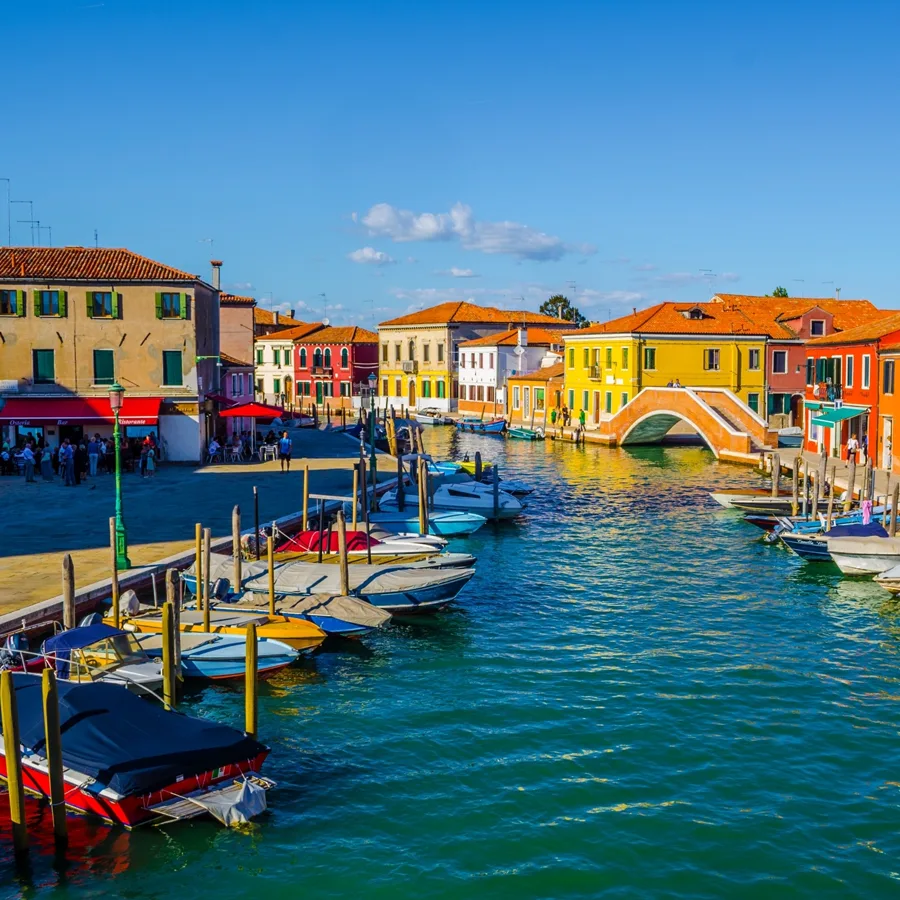
Day 9
Venice
Day 9
Venice


Early Morning/Morning
Visit to the Islands of Murano & Burano
Explore the intricacies of two famed Italian handicrafts with a day trip from Venice to the nearby islands of Murano and Burano. Stop by a glass factory or two and watch a live demonstration of glass artisans at work on the island of Murano, before hopping over to Burano, known for its brightly colored buildings and lace making, a tradition that dates back to the 16th Century. Both quiet islands offer a peaceful retreat from the often tourist filled squares of Venice's mainland. You can easily reach them by taking a guided tour or simply by catching the Vaporetto. It only takes about ten minutes to reach Murano from the F.te Nove stop, and another 30 minutes to reach Burano. Once arrived you will surely enjoy the laid-back island havens, both with their own Grand Canals, colorful buildings and a host of fascinating workshops, showrooms, and picturesque sidewalk cafes.

Museum of Lace (Museo del Merletto)
Observe firsthand one of the world's oldest and most famous traditions of lace making.
Show More

Burano's Colorful Houses
Take a walk through Venice's most colorful island and enjoy the unusual sight of its brightly-painted flourescent houses.
Show More

Glass Museum & Murano's Glass-Making Factories
See a superb collection of Venetian glass inside the Museum of Glass, and then stop by one of the island's workshops for a live demonstration.
Show More

Museum of Lace (Museo del Merletto)
Observe firsthand one of the world's oldest and most famous traditions of lace making.
Show More

Burano's Colorful Houses
Take a walk through Venice's most colorful island and enjoy the unusual sight of its brightly-painted flourescent houses.
Show More

Glass Museum & Murano's Glass-Making Factories
See a superb collection of Venetian glass inside the Museum of Glass, and then stop by one of the island's workshops for a live demonstration.
Show More

Museum of Lace (Museo del Merletto)
Observe firsthand one of the world's oldest and most famous traditions of lace making.
Show More
prev
next

Day 9
Venice

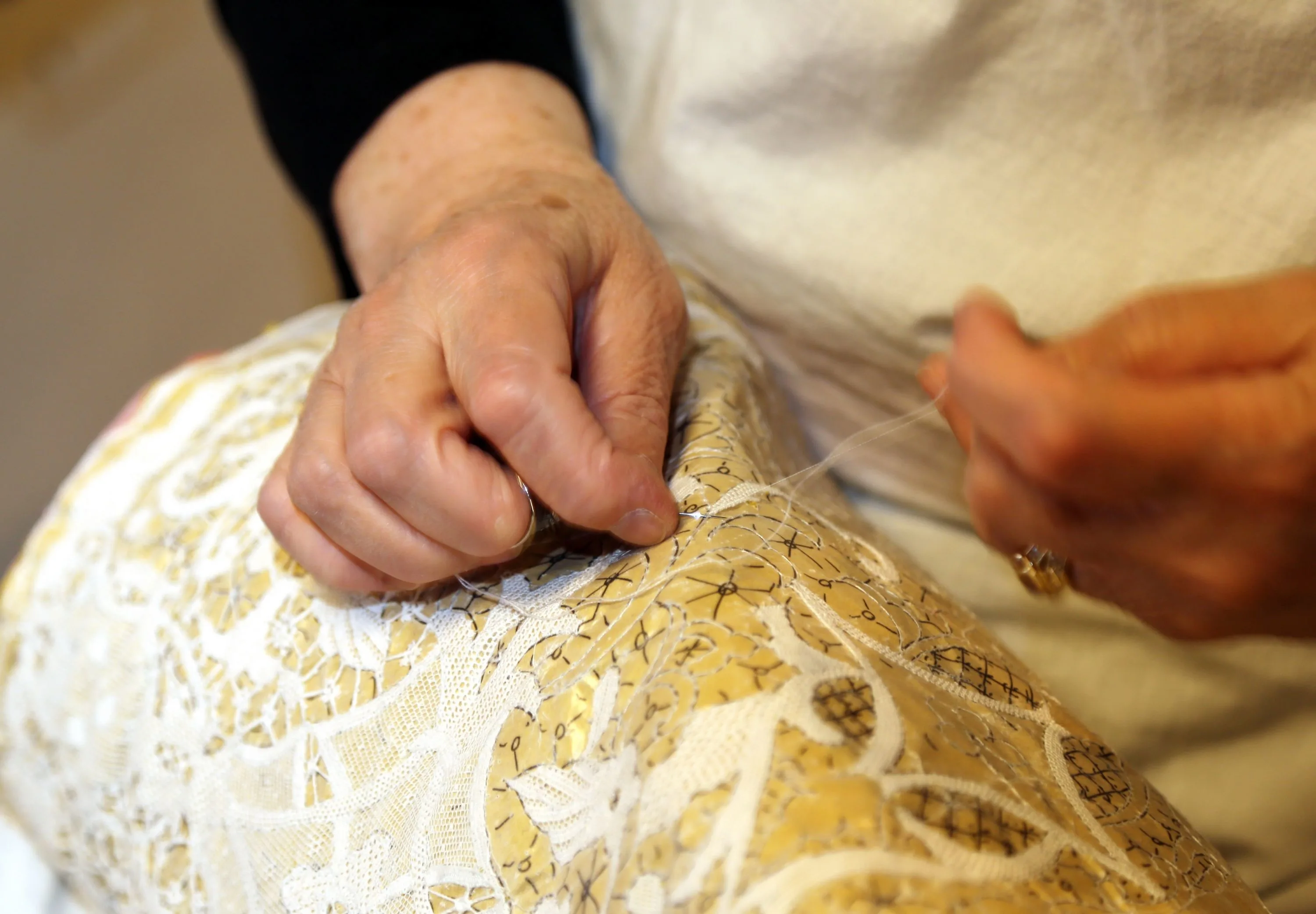
Museum of Lace (Museo del Merletto)
 Highlight of Murano & Burano
Highlight of Murano & BuranoObserve firsthand one of the world's oldest and most famous traditions of lace making.
Burano is historically a fishing village known for its handcrafted lace and technicolor houses. The legend goes that a sailor was lured to the island by a beautiful mermaid. She splashed her tail and created intricately patterned sea spray which she used as her wedding veil for her upcoming nuptials to the sailor. The village girls were very jealous of her veil and did their best to replicate the airy patterns with needle and thread, thus beginning Burano’s tradition of handcrafted lace. The Museo del Merletto was established in 1978 in the former gothic palace of the magistrate of Torcello. Inside the museum you can observe not only how the famous lace is made, but also learn about its history. You'll see artefacts from the collection of the Lace School of Burano, which occupied the building during the late 19th century.
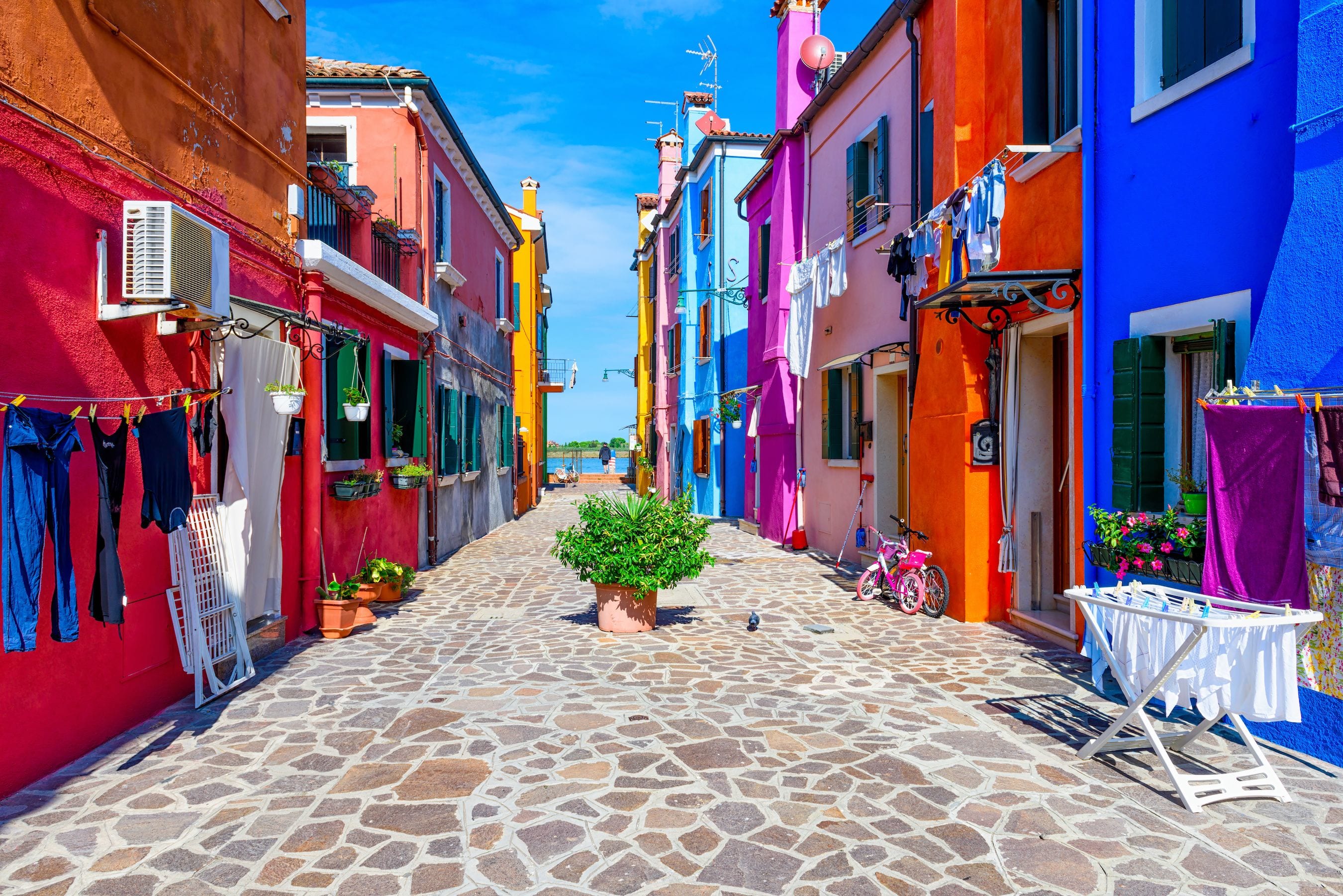
Burano's Colorful Houses
 Highlight of Murano & Burano
Highlight of Murano & BuranoTake a walk through Venice's most colorful island and enjoy the unusual sight of its brightly-painted flourescent houses.
Burano is filled with colorful houses famous for their fluorescent shades. The colors are heavily regulated in Burano (you have to write for permission before painting) and their origins disputed. Some say the houses were painted brightly so fisherman returning from the sea could spot their houses through the thick fog. A less romantic version say the houses were painted distinctively so fishermen could find their way home after a night on the town.
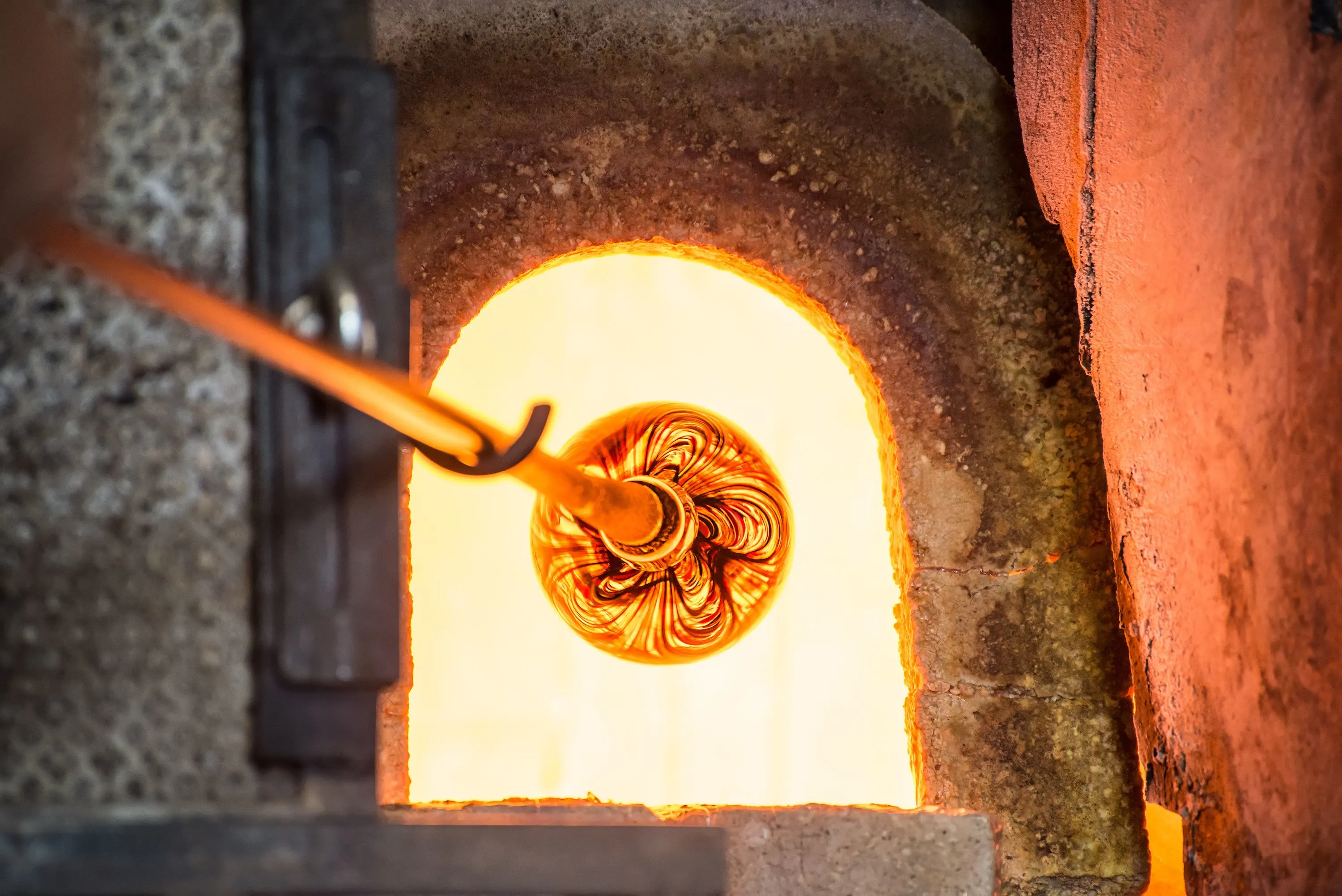
Glass Museum & Murano's Glass-Making Factories
 Highlight of Murano & Burano
Highlight of Murano & BuranoSee a superb collection of Venetian glass inside the Museum of Glass, and then stop by one of the island's workshops for a live demonstration.
Primarily known as the island of glass-making, Murano has sat at the epicenter of creative glassmaking for centuries. In the late 13th century Venice's Government deemed it too dangerous to have open furnaces in the city, as they posed a huge fire risk to a confined island city whose buildings were often made entirely of wood. Glass production was moved to the nearby island of Murano, and here the industry prospered. The Museum of Glass is housed inside an ancient palace and boasts a large collection of Murano glass, including world-class masterpieces by artists as Venini, Zecchin and Carlo Scarpa. Meanwhile, many of the island's workshops have belonged to the same families for centuries. Several furnaces are open to the public and you can watch short demonstrations. Be aware many also follow with a hard sales pitch, but you are never obligated to buy anything. A few tips: 1) The farther away from the Colonna Waterbus stop you walk—toward the glass museum and the Basilica of Santi Maria e Donato—the better the values. 2) Some glass houses—especially Barovier & Toso, Moretti, Pauly, Seguso, and Venini—command higher prices than others because of the quality of their work and the long tradition behind their names. 3) Shipping delicate pieces home can prove both costly and hazardous. If you do, don’t forget to get the seller’s email address, record the tracking number, and insure, insure, insure.

Museum of Lace (Museo del Merletto)
 Highlight of Murano & Burano
Highlight of Murano & BuranoObserve firsthand one of the world's oldest and most famous traditions of lace making.
Burano is historically a fishing village known for its handcrafted lace and technicolor houses. The legend goes that a sailor was lured to the island by a beautiful mermaid. She splashed her tail and created intricately patterned sea spray which she used as her wedding veil for her upcoming nuptials to the sailor. The village girls were very jealous of her veil and did their best to replicate the airy patterns with needle and thread, thus beginning Burano’s tradition of handcrafted lace. The Museo del Merletto was established in 1978 in the former gothic palace of the magistrate of Torcello. Inside the museum you can observe not only how the famous lace is made, but also learn about its history. You'll see artefacts from the collection of the Lace School of Burano, which occupied the building during the late 19th century.

Burano's Colorful Houses
 Highlight of Murano & Burano
Highlight of Murano & BuranoTake a walk through Venice's most colorful island and enjoy the unusual sight of its brightly-painted flourescent houses.
Burano is filled with colorful houses famous for their fluorescent shades. The colors are heavily regulated in Burano (you have to write for permission before painting) and their origins disputed. Some say the houses were painted brightly so fisherman returning from the sea could spot their houses through the thick fog. A less romantic version say the houses were painted distinctively so fishermen could find their way home after a night on the town.

Glass Museum & Murano's Glass-Making Factories
 Highlight of Murano & Burano
Highlight of Murano & BuranoSee a superb collection of Venetian glass inside the Museum of Glass, and then stop by one of the island's workshops for a live demonstration.
Primarily known as the island of glass-making, Murano has sat at the epicenter of creative glassmaking for centuries. In the late 13th century Venice's Government deemed it too dangerous to have open furnaces in the city, as they posed a huge fire risk to a confined island city whose buildings were often made entirely of wood. Glass production was moved to the nearby island of Murano, and here the industry prospered. The Museum of Glass is housed inside an ancient palace and boasts a large collection of Murano glass, including world-class masterpieces by artists as Venini, Zecchin and Carlo Scarpa. Meanwhile, many of the island's workshops have belonged to the same families for centuries. Several furnaces are open to the public and you can watch short demonstrations. Be aware many also follow with a hard sales pitch, but you are never obligated to buy anything. A few tips: 1) The farther away from the Colonna Waterbus stop you walk—toward the glass museum and the Basilica of Santi Maria e Donato—the better the values. 2) Some glass houses—especially Barovier & Toso, Moretti, Pauly, Seguso, and Venini—command higher prices than others because of the quality of their work and the long tradition behind their names. 3) Shipping delicate pieces home can prove both costly and hazardous. If you do, don’t forget to get the seller’s email address, record the tracking number, and insure, insure, insure.

Museum of Lace (Museo del Merletto)
 Highlight of Murano & Burano
Highlight of Murano & BuranoObserve firsthand one of the world's oldest and most famous traditions of lace making.
Burano is historically a fishing village known for its handcrafted lace and technicolor houses. The legend goes that a sailor was lured to the island by a beautiful mermaid. She splashed her tail and created intricately patterned sea spray which she used as her wedding veil for her upcoming nuptials to the sailor. The village girls were very jealous of her veil and did their best to replicate the airy patterns with needle and thread, thus beginning Burano’s tradition of handcrafted lace. The Museo del Merletto was established in 1978 in the former gothic palace of the magistrate of Torcello. Inside the museum you can observe not only how the famous lace is made, but also learn about its history. You'll see artefacts from the collection of the Lace School of Burano, which occupied the building during the late 19th century.
prev
next


Day 10
Depart Venice
Day 10
Depart Venice

To Be Determined
Transfer to Airport by Taxi or Water Bus
Most visitors will depart from the Venice Marco Polo Airport, which is located just across the water on the mainland. Because of the impossibility of driving inside Venice, you will need to take a water bus to Piazzale Roma on the edge of the city and then a land taxi to the airport (40 EUR), or take a water bus directly to the airport (15 EUR). It is also possible to take a private water taxi directly from your hotel to the airport, but it's very expensive. If you are departing from Venice Treviso Airport, you have much further to go. You can either take an expensive taxi ride (about 100 EUR) or take a shuttle bus for 12 EUR. The ATVO line departs from Piazzale Roma and takes 70 minutes, while the Barzi line picks up at the less convenient Tronchetto (the docks) but only takes 40 minutes.

Day 10
Depart Venice


What's Included In Your Trip

Pre-Paid Tours and Activities:
- Heart of the Empire - Private Tour of Ancient Rome & the Colosseum
- Twilight Trastevere Group Food Tour
- Best of Florence: Half-Day Walking Tour
- Tuscan Cuisine Cooking Class
- 'First Walk' Guided Tour in Venice
- Private Gondola Ride
- City Card for Rome, including discounts to many popular attractions

Pre-Paid Transportation:
- 2nd Class Train Tickets from Rome-Florence
- 2nd Class Train Tickets from Florence-Venice
- Public Transport Tickets for Venice and Rome
- Private Transfer from Rome Fiumicino to Hotel
- Private Transfer to Rome Termini Train Station

Accommodation:
- 4 nights at a hotel of your choice in Rome
- 4 nights at a hotel of your choice in Florence
- 4 nights at a hotel of your choice in Venice

Go Real Travel Mobile App:
- Itinerary Plan & Reservations Info
- Points of Interest
- Detailed Travel Information
- Maps & Directions
Other Trips You May Like

12 Days
From$3175USD
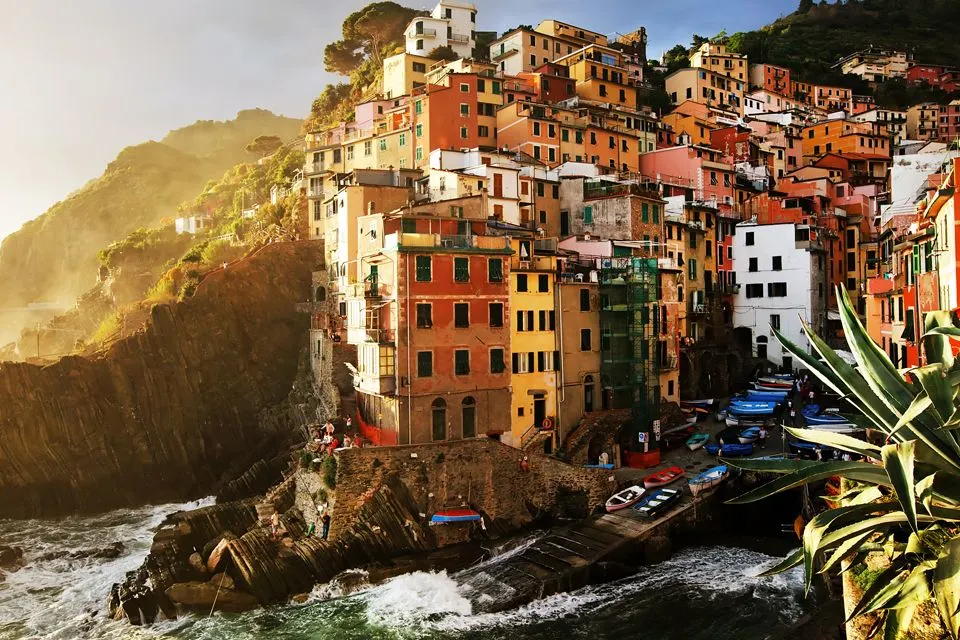
10 Days
From$4600USD

12 Days
From$2999USD

15 Days
From$4266USD

7 Days
From$2139USD
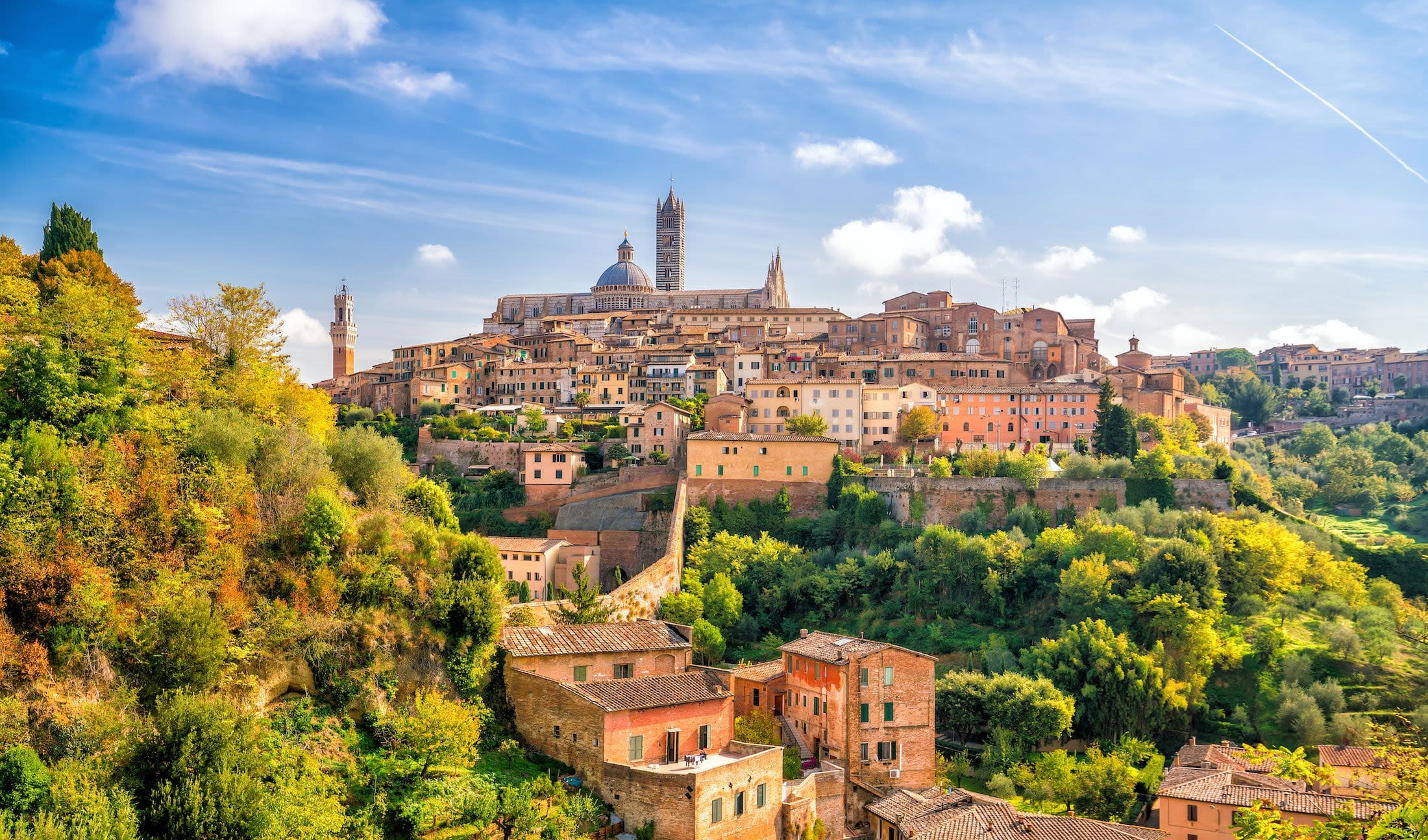
14 Days
From$3559USD
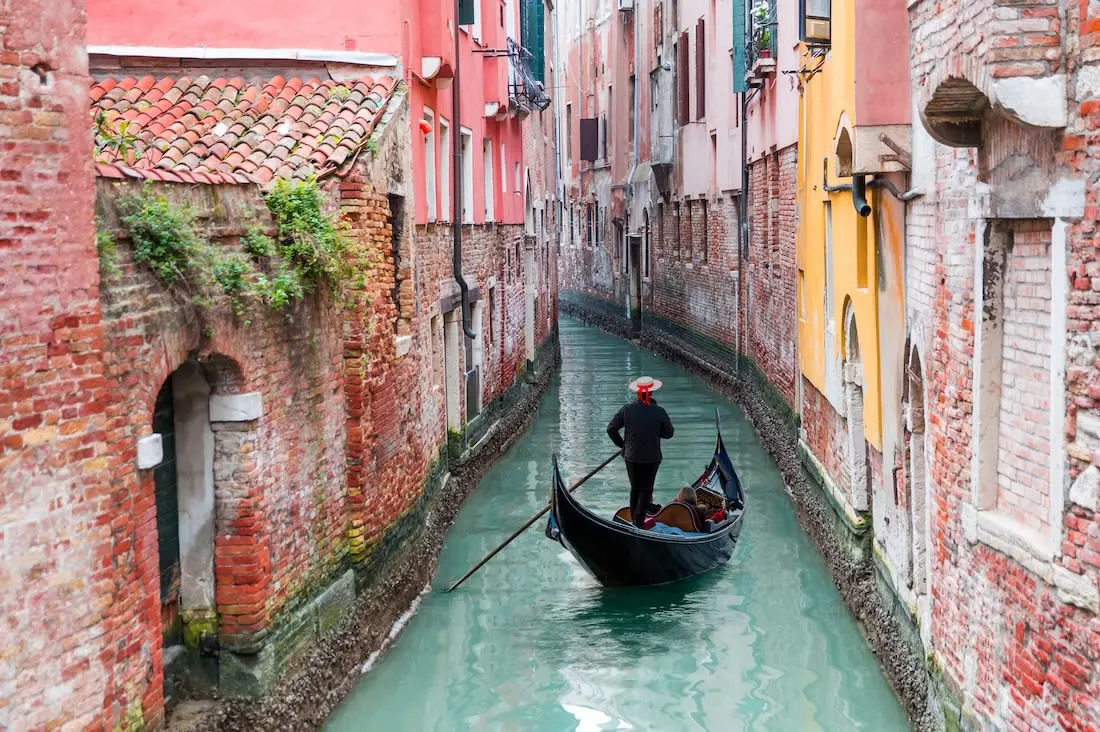
8 Days
From$2424USD

12 Days
From$3129USD

10 Days
From$2600USD

12 Days
From$3175USD

10 Days
From$4600USD

12 Days
From$2999USD

15 Days
From$4266USD

7 Days
From$2139USD

14 Days
From$3559USD

8 Days
From$2424USD

12 Days
From$3129USD

10 Days
From$2600USD
prev
next
Featured Blogs
prev
next
Our Customers Say It Best
Marianne Strydom, Paarl, South Africa
I just wanted to thank you for organizing an amazing trip for me – I packed in so much in such a short period of time and everything was just perfect. The way you do things makes it possible to really get to know the destination, which for me as a travel agent could not have been better. 

Otto Chuy, Los Angeles, California
I am still surprised how everything worked as planned, without a hitch. All instructions in your itinerary were precise and correct. Your suggestions and comments in each of the locations we went to were very helpful. All your guides, without exception, were wonderful and exactly on time. 

Malini Dutta, Boston, Massachusetts
We can't thank you enough for the detailed plans, maps, and suggestions. It really felt that someone was holding our hands and showing us around. We had all the excitement of discovering foreign lands, with none of the problems that can happen while negotiating unfamiliar places. In fact, all the cities felt like home within a few hours of arriving and exploring. 

Bev and Mark Frankel, Williamsburg, Virginia
We could not be more pleased with Go Real Travel! You took the guess work out of things like public transport but still managed to allow us the freedom to tour as we wanted. Our guides were exceptional and every time I saw a Viking Cruise tour of 25 people, I realized the quality experience we were getting with Go Real. 

Marianne Strydom, Paarl, South Africa
I just wanted to thank you for organizing an amazing trip for me – I packed in so much in such a short period of time and everything was just perfect. The way you do things makes it possible to really get to know the destination, which for me as a travel agent could not have been better. 

Otto Chuy, Los Angeles, California
I am still surprised how everything worked as planned, without a hitch. All instructions in your itinerary were precise and correct. Your suggestions and comments in each of the locations we went to were very helpful. All your guides, without exception, were wonderful and exactly on time. 

Malini Dutta, Boston, Massachusetts
We can't thank you enough for the detailed plans, maps, and suggestions. It really felt that someone was holding our hands and showing us around. We had all the excitement of discovering foreign lands, with none of the problems that can happen while negotiating unfamiliar places. In fact, all the cities felt like home within a few hours of arriving and exploring. 

Bev and Mark Frankel, Williamsburg, Virginia
We could not be more pleased with Go Real Travel! You took the guess work out of things like public transport but still managed to allow us the freedom to tour as we wanted. Our guides were exceptional and every time I saw a Viking Cruise tour of 25 people, I realized the quality experience we were getting with Go Real. 



Explore cities in more detail
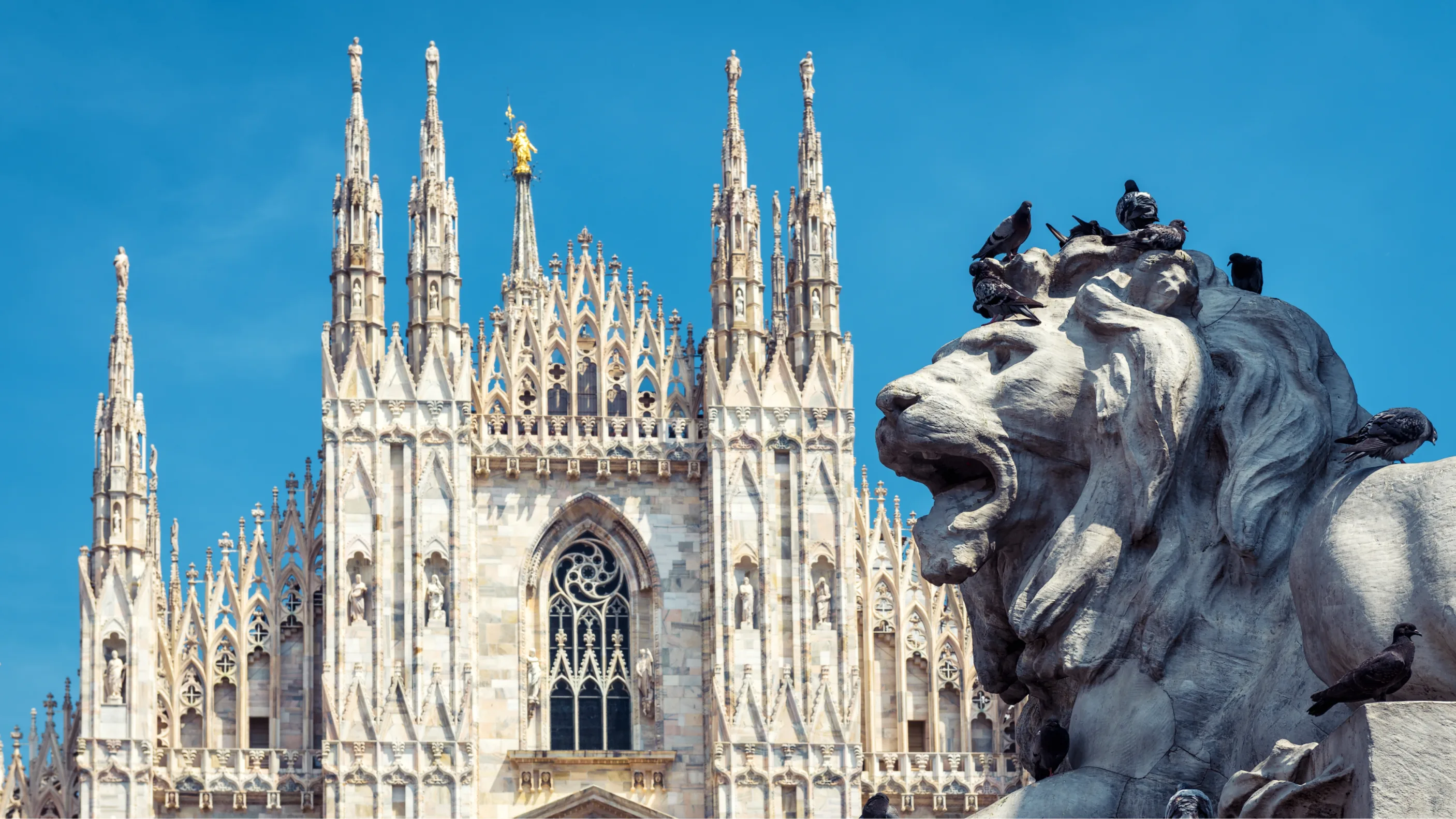
Milan
Milan is Italy’s most forward-looking city. An international center for fashion, fine dining, and design, it seems as though Milanese people breathe style. From the gleam on your wine glass to the twists of its cathedral’s spires, everything in Milan is finished to perfection. Home to the Italian stock exchange, a world-famous fashion industry, and a frantic business district, Milan is fast-paced and commercially minded. The shopping in Milan is second to none. At the Galleria Vittorio Emanuele II, one of the world’s oldest shopping malls, a glass-iron ceiling soars over brands like Louis Vuitton, Gucci, Massimo Dutti, and Amani. Along with the fashion, Milan’s cathedral, castle, and canals are also must-sees. But to view the city’s most prized possession - Leonardo da Vinci’s Last Supper, you must make an appointment. Tickets to view this mural sell out weeks in advance. It is truly a bucket-list worthy work of art. After a day taking in all the glamor and culture, take a seat in one of Milan’s well-appointed eateries. The Navigli Quarter is packed with restaurants, bars, and cafes, perfect for a relaxed Aperol spritz or pizza along the city’s canals.

Learn About Milan
Build Milan Trip

Cinque Terre
Cinque Terre, a string of five fishing villages in the Liguria region of Italy, is a rare snapshot of a traditional way of life. Rustic and charming, these clusters of pastel houses clinging to steep Mediterranean cliffs hold a special allure. Hiking between the five villages is a popular way to experience the rugged Mediterranean landscape close up. There are no roads here — the only other way to get between the villages is by boat or train. Seafood, hauled in from the azure waters of the sea that laps against the rocky shore, is abundant and delicious here. It pairs well with the local wine, and perhaps a plate of olives. Cinque Terre is a place to take it slow, to breathe in the fresh sea air and bask in the balmy climate, many miles from the chaos and frenzy of the modern world.

Learn About Cinque Terre
Build Cinque Terre Trip
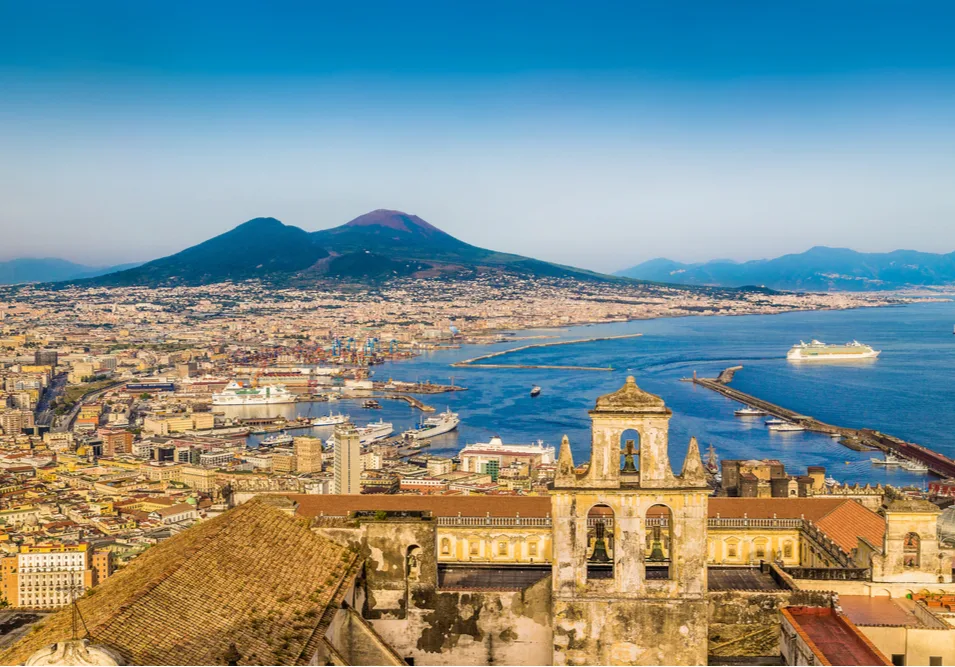
Naples
Gritty and chaotic Naples calls to travelers who want to experience the real Italy. Pressed along the coast of Campania, hilly Naples is jammed with maze-like streets, strung with outdoor clotheslines, descending toward the sea below. A much deserved UNESCO World Heritage site, Naples is famous for its churches, museums, castles, and catacombs. As you navigate the city, you’ll find yourself immersed by its culture and history. You can easily occupy a full day gazing at churches like the Naples Cathedral, San Francesco di Paola, and Cappella Sansevero. If you cast your eyes toward the Gulf of Naples, you’ll see Mount Vesuvius looming over the harbor. This foreboding volcano erupted in AD 79. Not far from the inner city — less than an hour by train — you’ll find the ancient town of Pompeii, its dramatic ruins still preserved in ash from the eruption. One of the best things you can do in Naples is to eat. This is the city where pizza was born. Propped up by its ripe tomatoes, local cheeses, and fresh fish, food from Naples has come to define what many see as the height of Italian cuisine. Everything you taste in Naples seems like a delicacy. Authentic and vivid, Naples is a true Italian city where the ancient world meets the modern-day with a bang.

Learn About Naples
Build Naples Trip
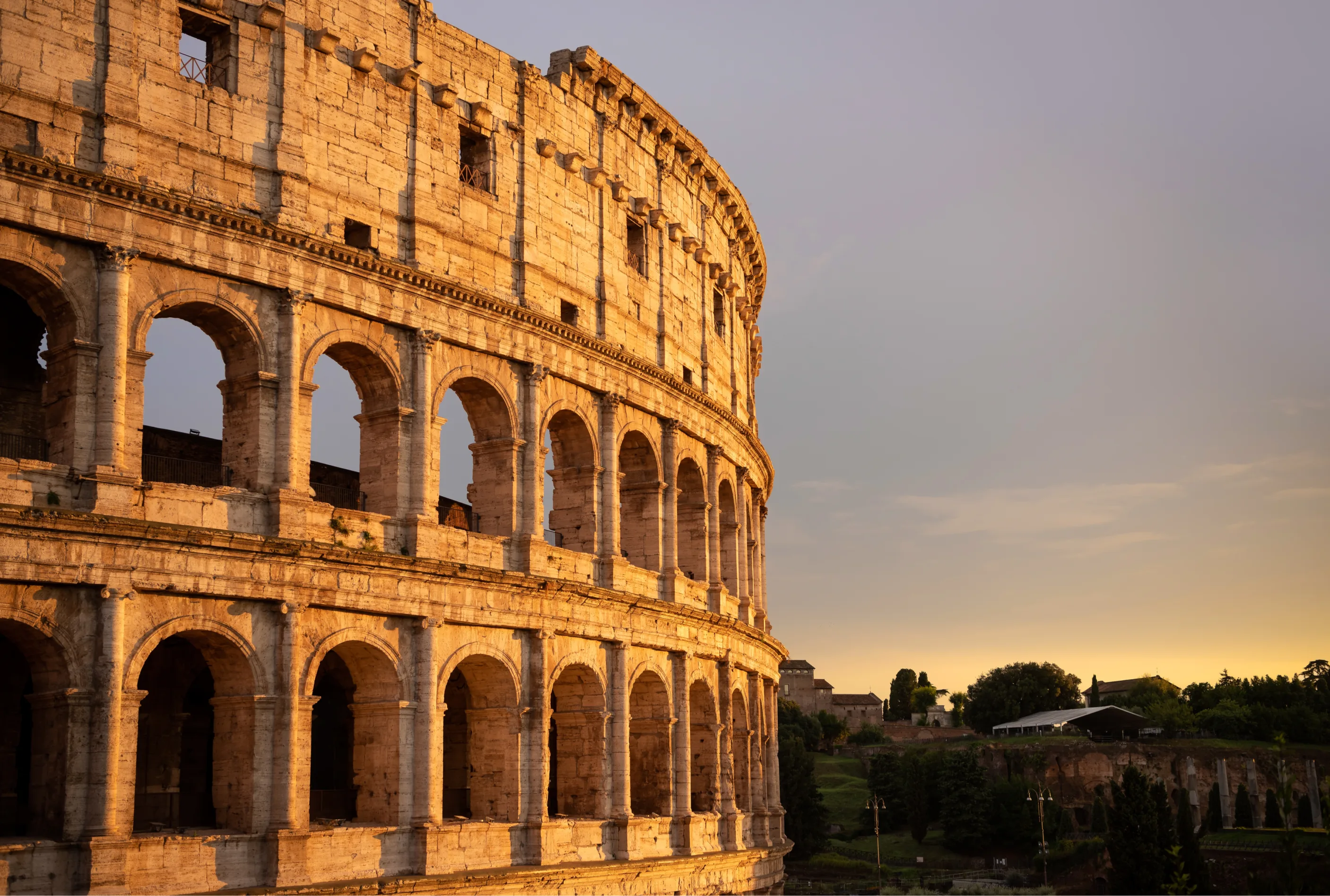
Rome
One of the must-sees of Italy, and indeed all of Europe, Rome is a city with history flowing through its veins. There is an endless amount to see, do, and learn here, with something for every taste and disposition. Rome was the center of Western civilization for a Millenium and during that time, accumulated a list of historical and cultural treasures that no other destination can truly match. The Pantheon, Colosseum, Roman Forum, and Cirus of Maxentius are just a few examples of what can be seen and experienced in Rome, which at times feels more like a giant outdoor museum than a city. At Rome’s heart, you’ll find the Vatican, home of the Roman Catholic Church and the Pope. Here visitors can see the legendary Sistine Chapel. Transcending a mere building, the chapel is a walk-in work of art. Although historical sights can be found on just about every corner, it’s entirely possible to fill a day just wandering around Rome. The city’s charming streets and open Piazzas are filled with beautiful sights and places to sit, grab the best Cappuccino in the world, and enjoy the view.

Learn About Rome
Build Rome Trip
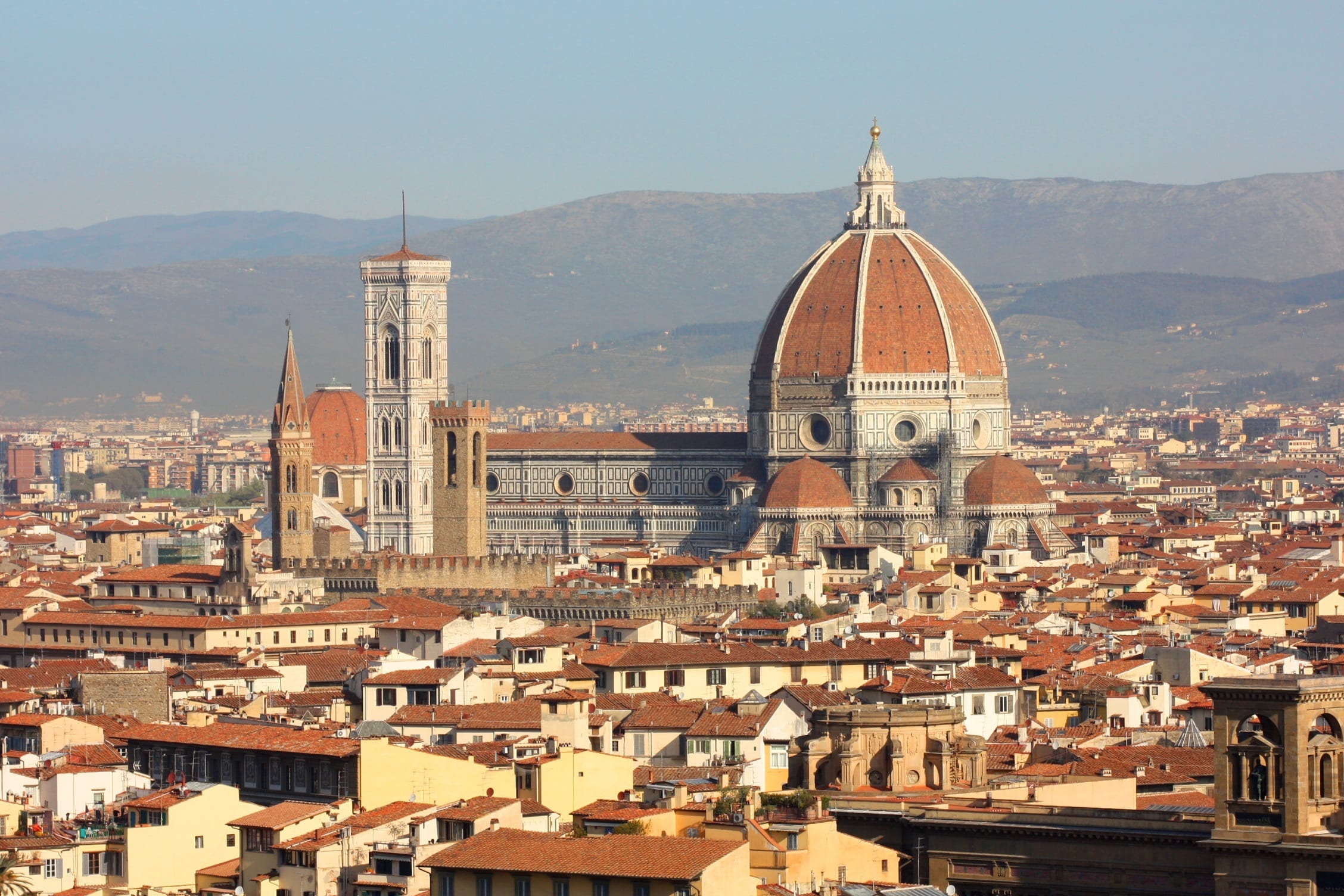
Florence
Culture and history are thick in the air in Florence. Located on the banks of the Arno River in Tuscany, Florence’s past is deeply compelling. The birthplace of the Renaissance, Florence is where innovators like Dante, Machiavelli, Michelangelo, and Da Vinci made their fortunes. Centuries of art, politics, and commerce have left their mark on every stone in this Northern Italian city. In the 15th and 16th centuries, Florentine banks funded new enterprises that went on to change the history of the world. Powerful families like the Medici’s financed some of the finest art in history and pioneered new ways of doing statecraft and politics. As you stand in the Piazzale Michelangelo and gaze upon the city below it’s hard to take it all in at once. It feels like behind every door in Florence might hide a work of genius. Michelangelo’s David and Botticelli’s Primavera can be found just a short walk away. After a long day wandering the streets and gazing at art, fueled by exquisite coffee and gelato, relax like the locals do: with a glass of some of the best wine in the world.

Learn About Florence
Build Florence Trip
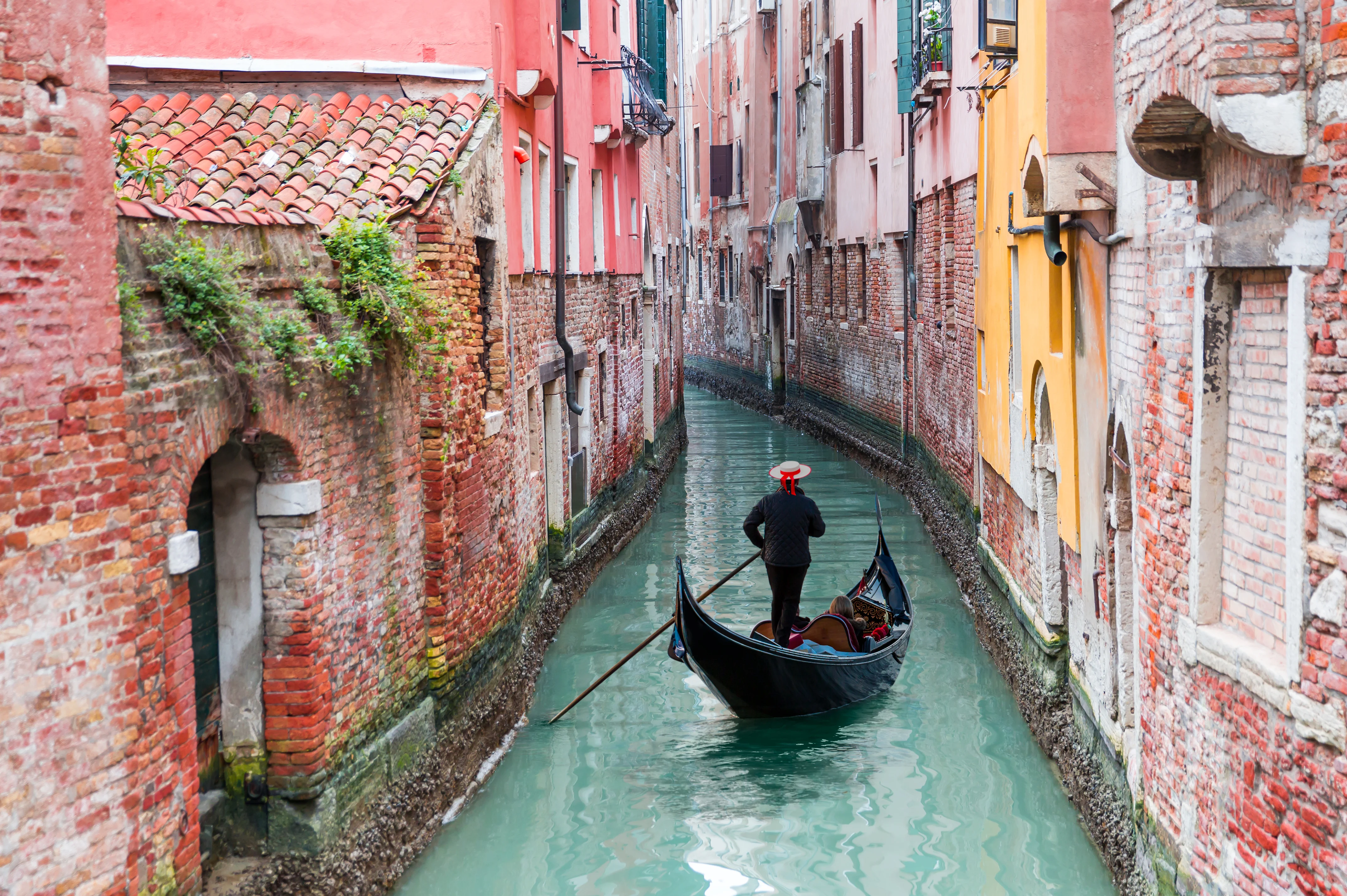
Venice
Venice is a city with no equal. Built on a series of islands on a lagoon, it was once a powerful city-state. Echoes of that old magnificence can be seen everywhere here, from the stunning buildings that rise out of the canals, to the bridges that arc across them. Take a Gondola ride through the canals that form the city’s veins, or wander through the winding streets drinking in the sights. You’ll see Venice attracts tourists in huge numbers, and that’s with good reason. It’s home to a seemingly limitless amount of art, culture, history, and architecture. St Mark’s Basilica, the Doge’s Palace, and the Campanile di San Marco just barely scratch the surface. There’s a 700-year-old market, Rialto, which is still open today. The Ponte di Rialto bridge connects the neighborhoods of San Marco and San Polo, stretching across the Grand Canal. Venice has weathered the last several centuries with elegance and pride, a place that will surpass even your highest expectations.

Learn About Venice
Build Venice Trip

Milan
Milan is Italy’s most forward-looking city. An international center for fashion, fine dining, and design, it seems as though Milanese people breathe style. From the gleam on your wine glass to the twists of its cathedral’s spires, everything in Milan is finished to perfection. Home to the Italian stock exchange, a world-famous fashion industry, and a frantic business district, Milan is fast-paced and commercially minded. The shopping in Milan is second to none. At the Galleria Vittorio Emanuele II, one of the world’s oldest shopping malls, a glass-iron ceiling soars over brands like Louis Vuitton, Gucci, Massimo Dutti, and Amani. Along with the fashion, Milan’s cathedral, castle, and canals are also must-sees. But to view the city’s most prized possession - Leonardo da Vinci’s Last Supper, you must make an appointment. Tickets to view this mural sell out weeks in advance. It is truly a bucket-list worthy work of art. After a day taking in all the glamor and culture, take a seat in one of Milan’s well-appointed eateries. The Navigli Quarter is packed with restaurants, bars, and cafes, perfect for a relaxed Aperol spritz or pizza along the city’s canals.

Learn About Milan
Build Milan Trip

Cinque Terre
Cinque Terre, a string of five fishing villages in the Liguria region of Italy, is a rare snapshot of a traditional way of life. Rustic and charming, these clusters of pastel houses clinging to steep Mediterranean cliffs hold a special allure. Hiking between the five villages is a popular way to experience the rugged Mediterranean landscape close up. There are no roads here — the only other way to get between the villages is by boat or train. Seafood, hauled in from the azure waters of the sea that laps against the rocky shore, is abundant and delicious here. It pairs well with the local wine, and perhaps a plate of olives. Cinque Terre is a place to take it slow, to breathe in the fresh sea air and bask in the balmy climate, many miles from the chaos and frenzy of the modern world.

Learn About Cinque Terre
Build Cinque Terre Trip

Naples
Gritty and chaotic Naples calls to travelers who want to experience the real Italy. Pressed along the coast of Campania, hilly Naples is jammed with maze-like streets, strung with outdoor clotheslines, descending toward the sea below. A much deserved UNESCO World Heritage site, Naples is famous for its churches, museums, castles, and catacombs. As you navigate the city, you’ll find yourself immersed by its culture and history. You can easily occupy a full day gazing at churches like the Naples Cathedral, San Francesco di Paola, and Cappella Sansevero. If you cast your eyes toward the Gulf of Naples, you’ll see Mount Vesuvius looming over the harbor. This foreboding volcano erupted in AD 79. Not far from the inner city — less than an hour by train — you’ll find the ancient town of Pompeii, its dramatic ruins still preserved in ash from the eruption. One of the best things you can do in Naples is to eat. This is the city where pizza was born. Propped up by its ripe tomatoes, local cheeses, and fresh fish, food from Naples has come to define what many see as the height of Italian cuisine. Everything you taste in Naples seems like a delicacy. Authentic and vivid, Naples is a true Italian city where the ancient world meets the modern-day with a bang.

Learn About Naples
Build Naples Trip

Rome
One of the must-sees of Italy, and indeed all of Europe, Rome is a city with history flowing through its veins. There is an endless amount to see, do, and learn here, with something for every taste and disposition. Rome was the center of Western civilization for a Millenium and during that time, accumulated a list of historical and cultural treasures that no other destination can truly match. The Pantheon, Colosseum, Roman Forum, and Cirus of Maxentius are just a few examples of what can be seen and experienced in Rome, which at times feels more like a giant outdoor museum than a city. At Rome’s heart, you’ll find the Vatican, home of the Roman Catholic Church and the Pope. Here visitors can see the legendary Sistine Chapel. Transcending a mere building, the chapel is a walk-in work of art. Although historical sights can be found on just about every corner, it’s entirely possible to fill a day just wandering around Rome. The city’s charming streets and open Piazzas are filled with beautiful sights and places to sit, grab the best Cappuccino in the world, and enjoy the view.

Learn About Rome
Build Rome Trip

Florence
Culture and history are thick in the air in Florence. Located on the banks of the Arno River in Tuscany, Florence’s past is deeply compelling. The birthplace of the Renaissance, Florence is where innovators like Dante, Machiavelli, Michelangelo, and Da Vinci made their fortunes. Centuries of art, politics, and commerce have left their mark on every stone in this Northern Italian city. In the 15th and 16th centuries, Florentine banks funded new enterprises that went on to change the history of the world. Powerful families like the Medici’s financed some of the finest art in history and pioneered new ways of doing statecraft and politics. As you stand in the Piazzale Michelangelo and gaze upon the city below it’s hard to take it all in at once. It feels like behind every door in Florence might hide a work of genius. Michelangelo’s David and Botticelli’s Primavera can be found just a short walk away. After a long day wandering the streets and gazing at art, fueled by exquisite coffee and gelato, relax like the locals do: with a glass of some of the best wine in the world.

Learn About Florence
Build Florence Trip

Venice
Venice is a city with no equal. Built on a series of islands on a lagoon, it was once a powerful city-state. Echoes of that old magnificence can be seen everywhere here, from the stunning buildings that rise out of the canals, to the bridges that arc across them. Take a Gondola ride through the canals that form the city’s veins, or wander through the winding streets drinking in the sights. You’ll see Venice attracts tourists in huge numbers, and that’s with good reason. It’s home to a seemingly limitless amount of art, culture, history, and architecture. St Mark’s Basilica, the Doge’s Palace, and the Campanile di San Marco just barely scratch the surface. There’s a 700-year-old market, Rialto, which is still open today. The Ponte di Rialto bridge connects the neighborhoods of San Marco and San Polo, stretching across the Grand Canal. Venice has weathered the last several centuries with elegance and pride, a place that will surpass even your highest expectations.

Learn About Venice
Build Venice Trip
prev
next


 Map of Your Itinerary Route
Map of Your Itinerary Route
Zoom In to the cities to see your itinerary in more detail


 4.8
4.8 
